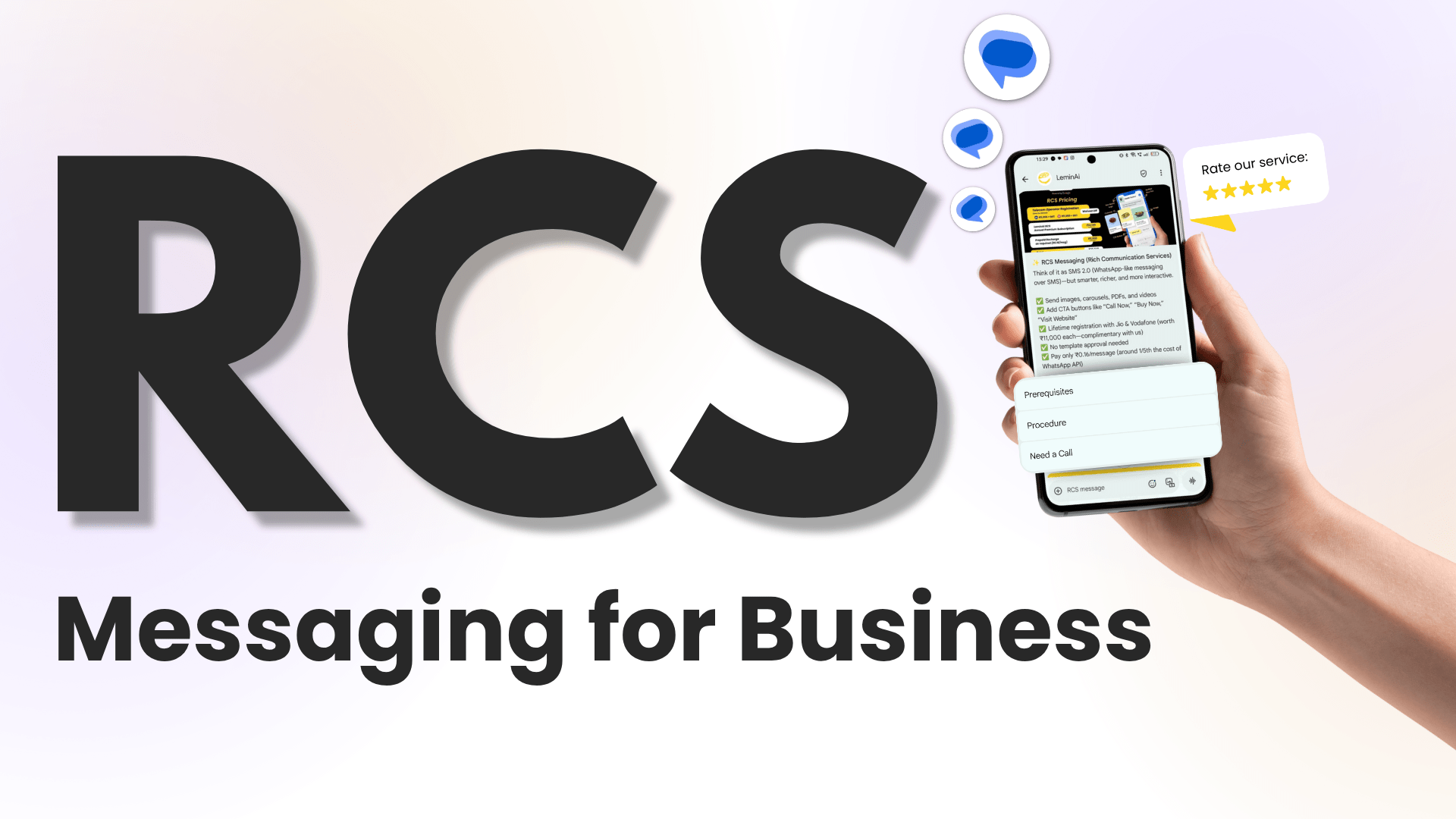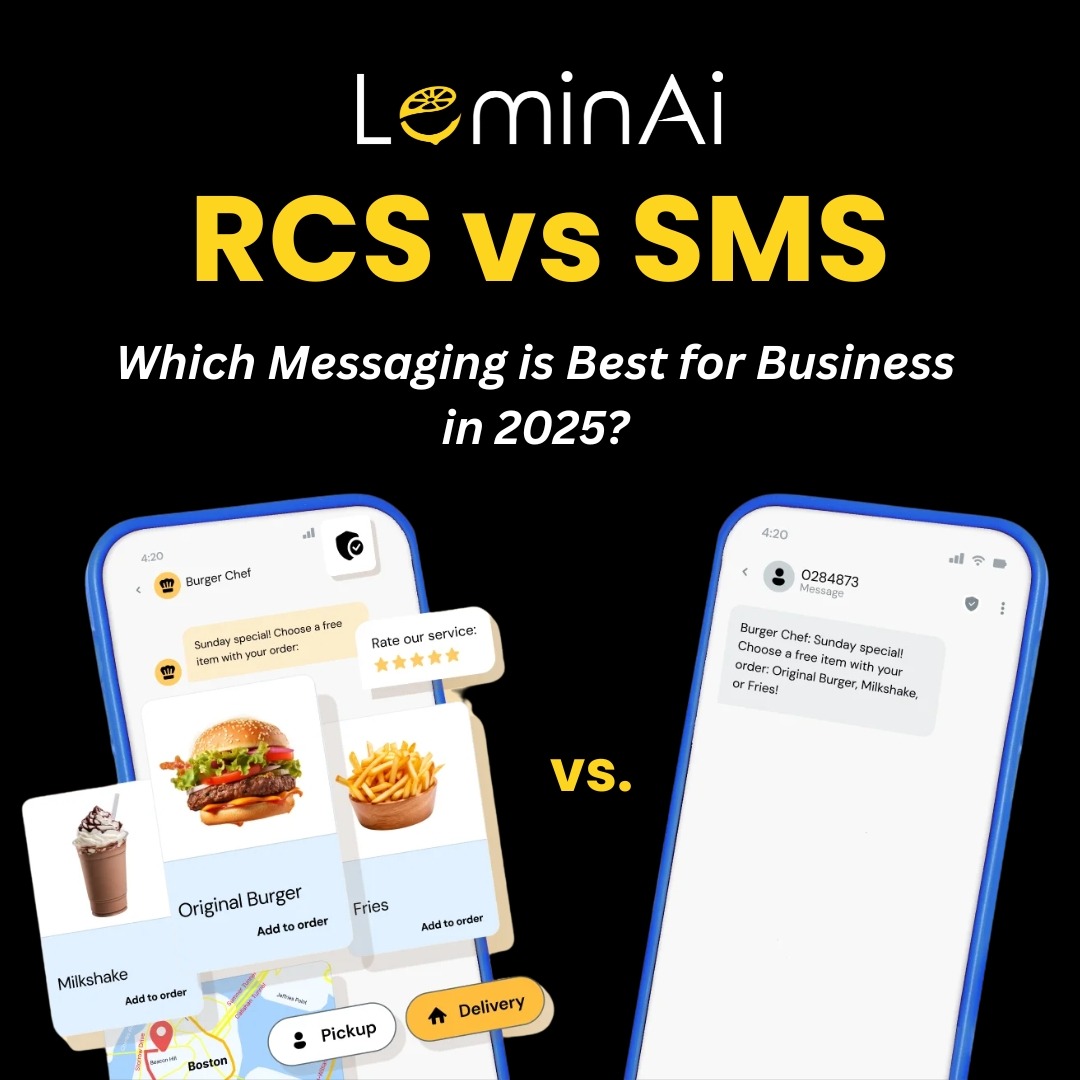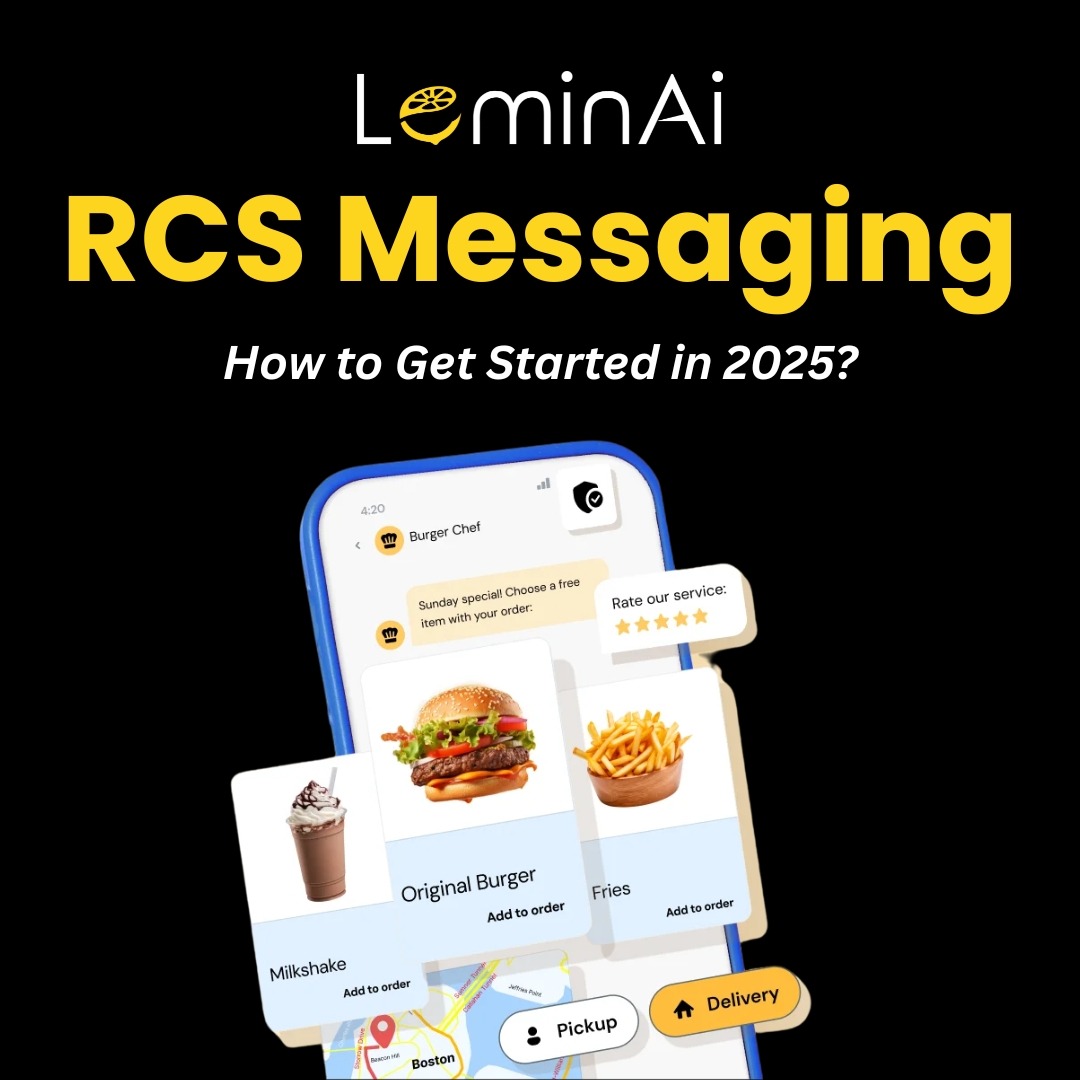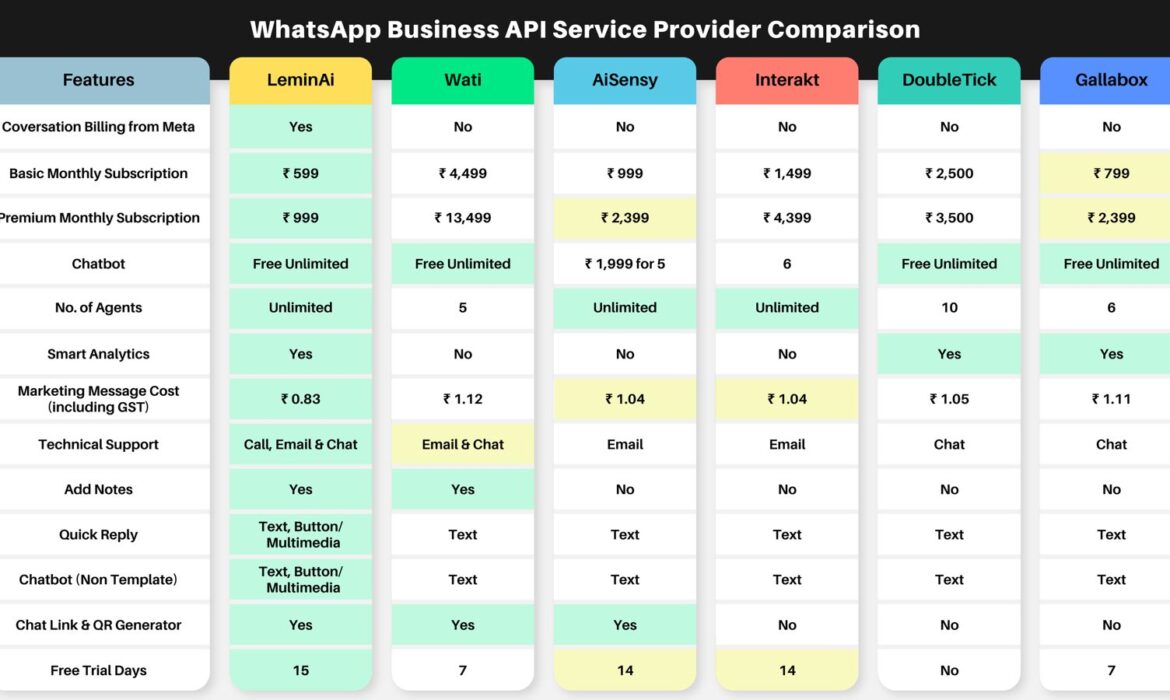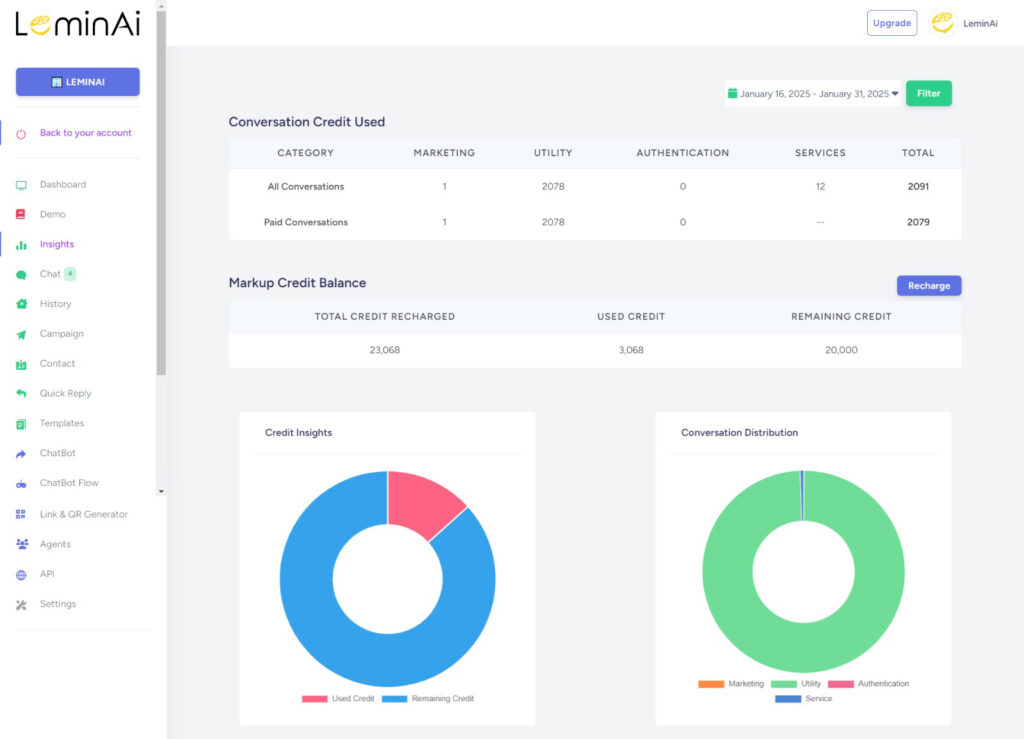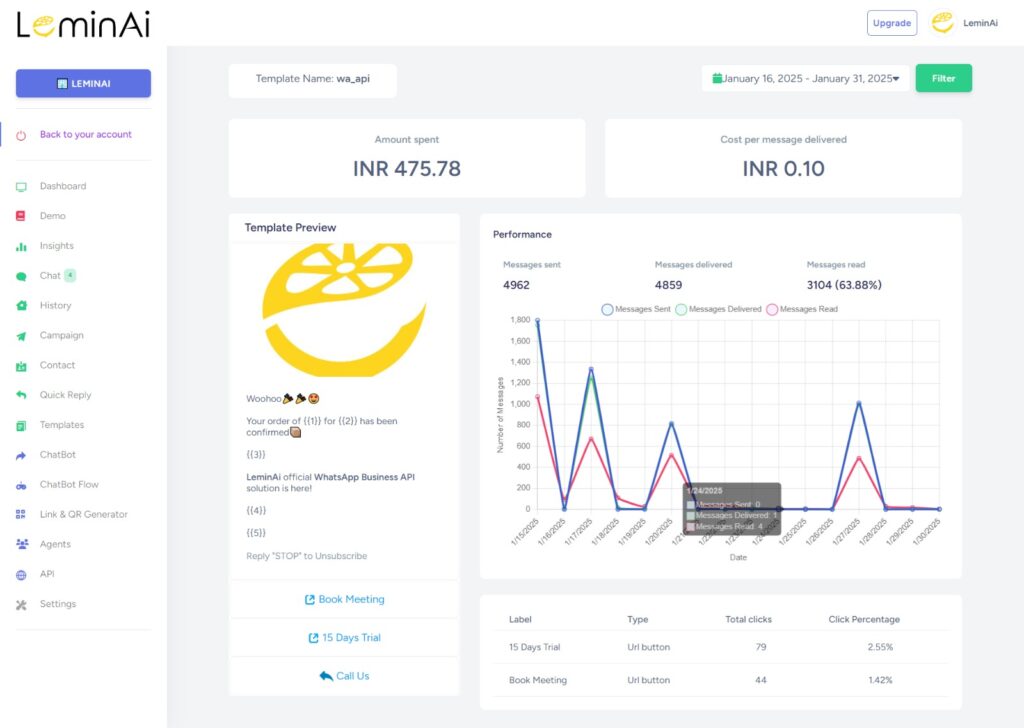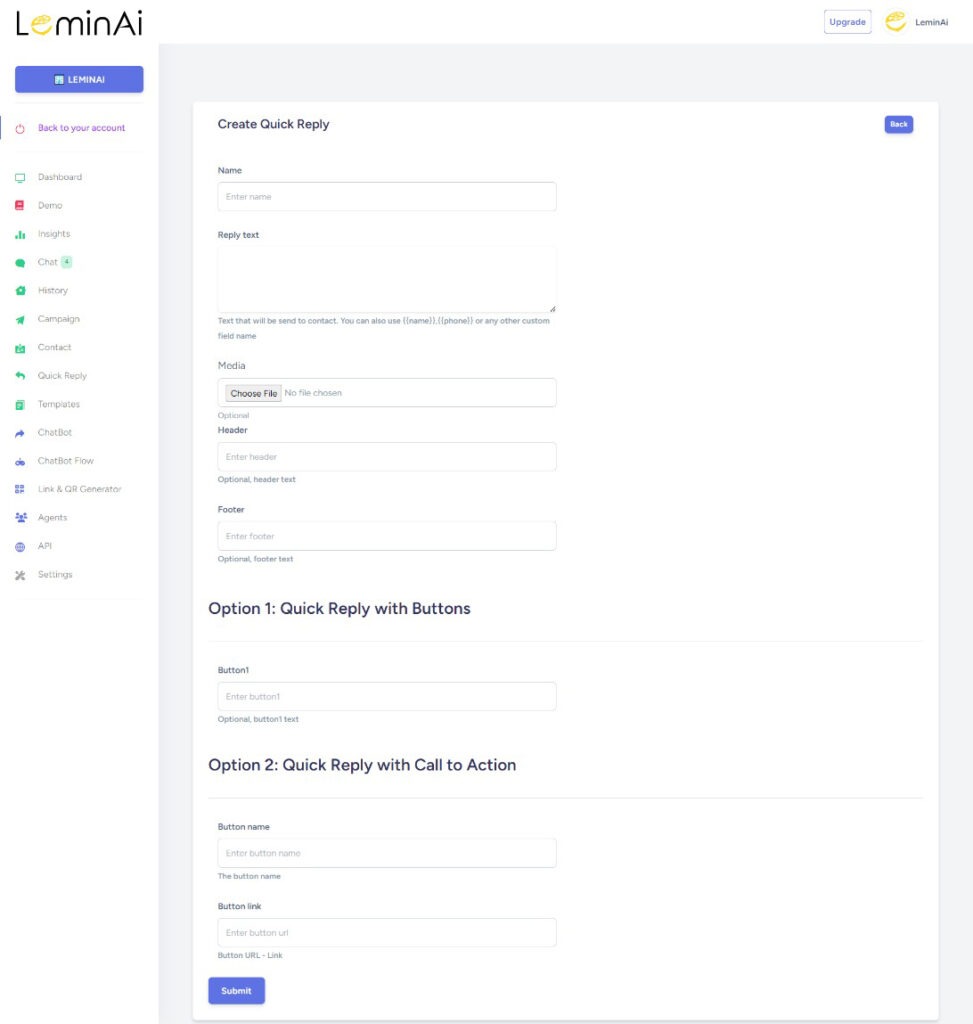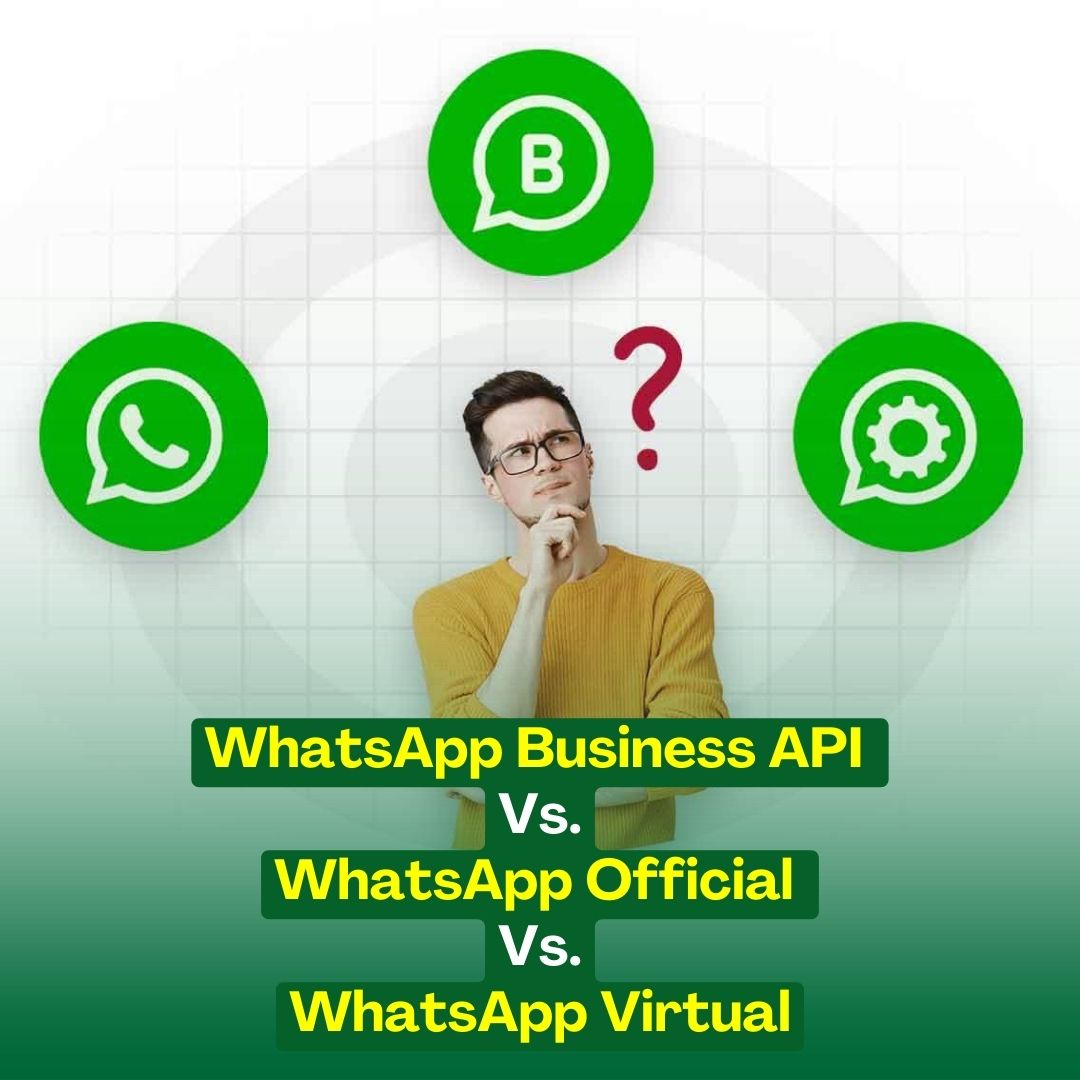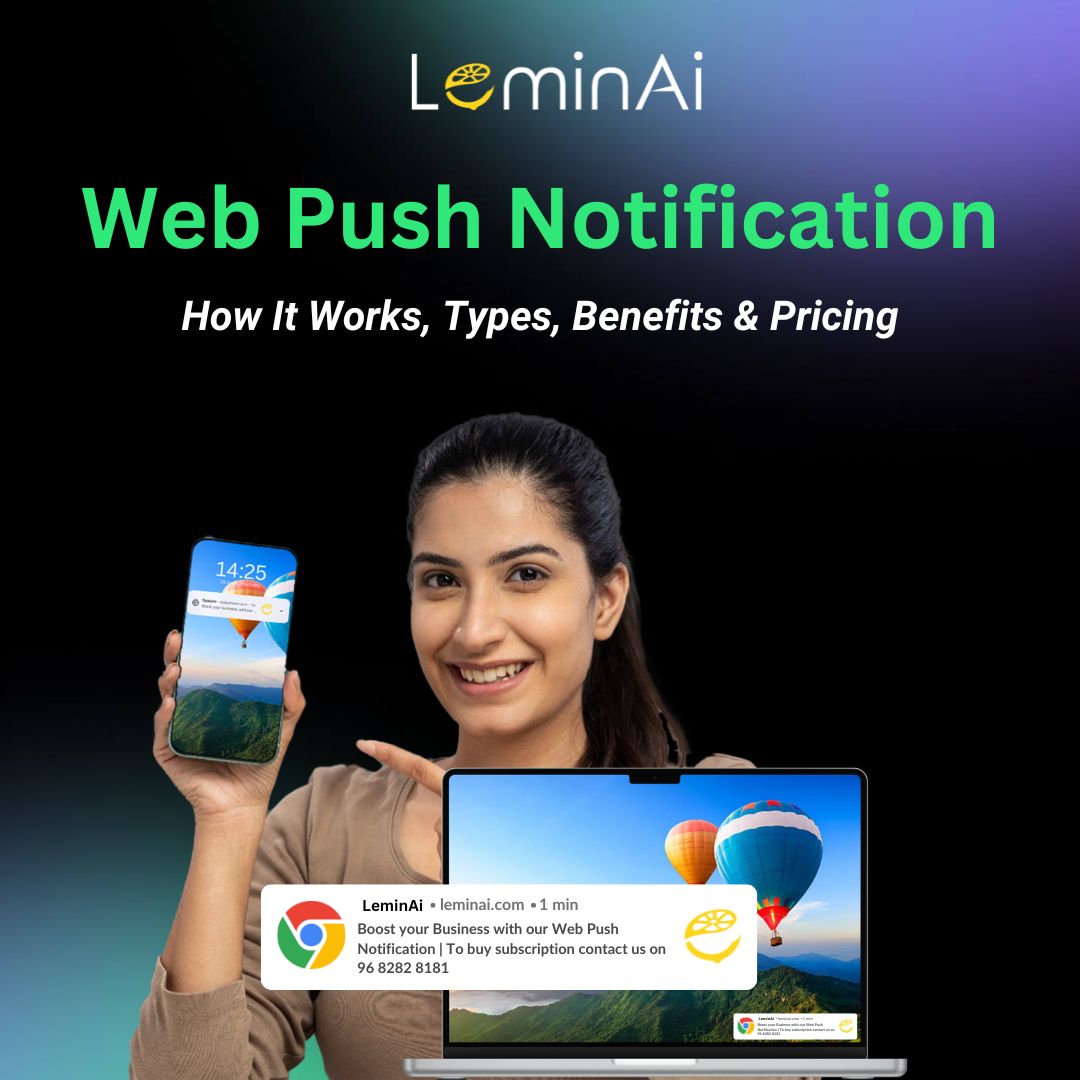How to use RCS for Business Effectively
RCS for Business is changing the way companies communicate with their customers. Unlike traditional SMS, RCS allows rich, interactive messaging that can include images, videos, buttons, and more. Businesses of all sizes can now create engaging conversations that improve customer experience and increase sales. In this guide, we will explain how to use RCS for Business effectively and provide tips, strategies as well as best practices.
Introduction to RCS for Business
What is RCS for Business?
RCS for Business stands for Rich Communication Services for Business. Basically, it is the upgraded version of traditional SMS. Instead of sending plain text, businesses can now send interactive and media-rich messages. These messages can include images, videos, carousels, buttons, and even suggested replies.
Unlike SMS, which is limited to 160 characters and basic delivery reports, RCS messages can carry more information and give users interactive options. Customers can see the sender’s verified business name and logo, making the message more trustworthy.
For example, instead of receiving a text that says, “Your order has been shipped”, customers could see:
- A branded message with your logo and company name
- A tracking button to check the status
- An image of the product they ordered
That is the power of RCS for Business.
Why Businesses Need RCS Messaging
Customers today expect more than plain text. Traditional SMS feels outdated in 2025 because it lacks interactivity. But with RCS, you can send messages from your Verified business profile which increase trust and reduce spam concerns, use Interactive buttons and carousels which make taking action easy and much much more.
On the other hand, businesses benefit from detailed analytics. Unlike SMS, RCS tells you whether a customer opened the message, clicked a button, or watched a video. Therefore, you gain insights to optimize campaigns.
In short, businesses need RCS because it creates stronger connections, improves engagement, and drives higher conversions compared to SMS.
Benefits of using RCS for Business
Businesses are constantly looking for smarter ways to connect with customers. While SMS worked for years, it feels limited today. RCS for Business goes beyond plain text and unlocks a modern way to communicate. Let’s look at the main benefits.
1. Higher Customer Engagement
RCS messages grab attention. They don’t look like boring text, they look like a chat conversation with rich media. Customers can interact with buttons, swipe through product carousels, or watch videos right inside the message.
For example, a retail store can send a carousel of product images with “Buy Now” buttons, or a travel agency can share flight details with a “Check-in” button.
Because the experience is interactive, customers engage more and take quicker action.
2. Trust and Authenticity with Verified Profiles
Spam messages are everywhere. Customers often hesitate to click SMS links because they don’t trust unknown numbers. RCS solves this problem by giving businesses a verified profile with brand name, logo, and official contact details.
When customers see your verified badge, they feel safe. That trust directly improves response rates and builds credibility.
3. Rich Media Messaging
Unlike SMS, RCS allows you to send:
- Images of your product or service
- Videos that explain or demonstrate
- GIFs or animations to catch attention
- Audio messages for added personalization
This means your message is no longer just text—it becomes a full storytelling tool.
4. Real-Time Analytics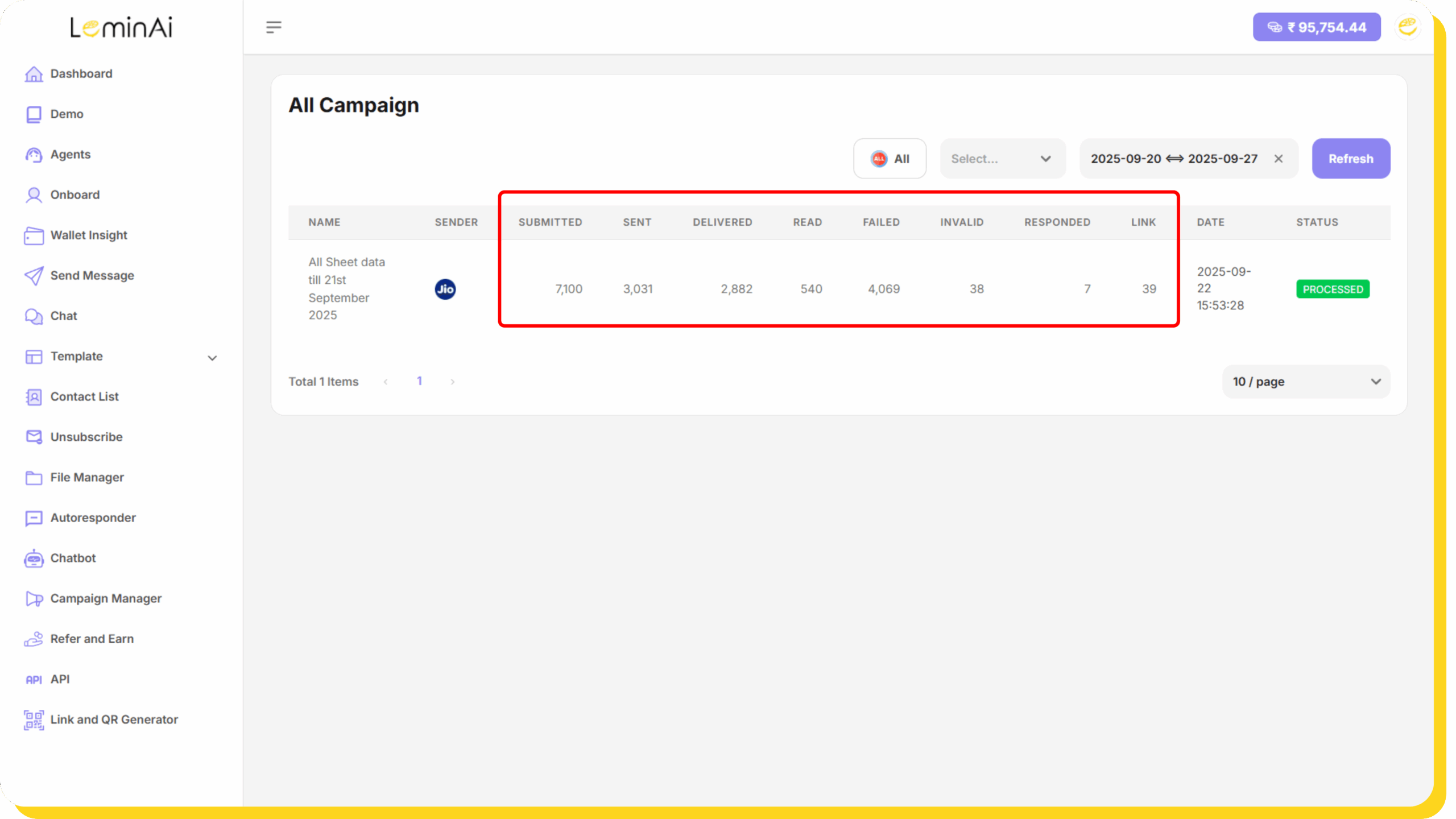
SMS gives you basic delivery status, but you never know if the customer read it. RCS changes that. You get detailed real-time analytics, such as:
- Messages Sent
- Messages Delivered
- Read Receipts
- Messages Responded to
- Button clicks
Therefore, you can measure the success of each campaign, learn what works, and improve results.
5. Personalisation at Scale
RCS allows you to send tailored messages based on customer data. You can include details such as the customer’s name, the product they purchased, the delivery date, or the date of their appointment.
For example, an e-commerce store can notify a customer, “Hi Sam, your order of the ABC headphones will be delivered on 30th September. Track your order here.” Similarly, a clinic can send a reminder like, “Hi Roy, your dental appointment is scheduled for 10 AM on 30th September.”
Even when sending hundreds or thousands of messages, each customer sees a message that feels individual and relevant. This kind of personalization builds trust and keeps customers engaged.
6. Better Conversions
Every marketing message has one goal “Conversion”. RCS simplifies the path to action with one-tap CTAs like “Shop Now,” “Book Appointment,” or “Learn More.” Because the process is smoother, conversion rates are higher compared to SMS or email.
In short, RCS for Business creates a richer, safer, and more measurable communication channel. Businesses that switch to RCS don’t just send messages, they create experiences.
Setting Up RCS for Business
Before sending RCS messages, businesses must set up their RCS account properly.
1. Choose a Verified RCS Provider
First, select a verified RCS business provider. Many platforms offer RCS services but ensure that the provider supports your region, delivers your messages properly and looks professional on your customers’ devices.
2. Register Your Business Profile
Next, register your business profile. A verified profile builds trust. To complete verification, you typically need to:
- Add your business name and logo
- Verify your phone number or domain
- Confirm your brand identity
Once verified, your messages show your logo and brand name, helping customers instantly recognize your business.
Note: Before launching your campaign, test your messages on different devices to make sure everything works correctly. Check that buttons and links function & images and videos display properly. Proper testing ensures your messages look professional and reach customer without issues.
Features of RCS Messages
RCS for Business is more than just an upgraded SMS. It brings a range of features that transform how businesses communicate with customers. These features make messaging interactive, personalized, and measurable.
1. Verified Business Profiles
One of the biggest advantages of RCS is brand verification. Verification helps reduce spam concerns and increases customer trust. Platforms like LeminAi simplify verification, letting businesses display their brand professionally in every message.
2. Rich Media Support
RCS supports a variety of media formats like Images and GIFs to showcase products or highlight promotions, Videos for tutorials, demos, or announcements and Audio clips for quick voice updates. By using rich media, businesses can grab attention and make messages more engaging and memorable than plain text.
3. Interactive Buttons and Carousels
RCS messages can include:
- Call-to-action buttons like “Shop Now,” “Book Appointment,” or “Track Order”
- Carousels that allow users to swipe through multiple options
These interactive elements let customers take action directly from the message, reducing friction and increasing conversions.
4. Suggested Replies and Quick Actions
RCS allows businesses to include suggested replies or quick action buttons, making it easier for customers to respond. For example:
- A customer support message might offer “Yes, I need help” or “No, thanks” buttons
- A booking reminder could include “Confirm” or “Reschedule” options
This improves response time and creates a seamless communication experience.
5. Autoresponders
Businesses can set up automatic replies to respond instantly when a customer sends a message. For example, “Thanks for reaching out! An agent will contact you shortly.” or “Your query has been received. We will respond within 2 hours.”
Autoresponders improve response time and maintain customer engagement, even outside business hours.
6. ChatBots
AI-powered chatbots handle common queries automatically. Chatbots can provide product recommendations, Confirm appointments or bookings, Answer FAQs, etc. This feature reduces the workload for customer support teams while maintaining 24/7 availability.
5. Multi-Agent Support
RCS enables multiple customer service agents to handle chats under a single business account. This is ideal for businesses that manage large volumes of queries. Unlike SMS, which is tied to one number, RCS provides scalable support without losing personalization.
6. Real-Time Analytics
RCS provides detailed insights that SMS cannot. Track delivery, read receipts, clicks, and engagement to measure campaign effectiveness and optimize performance. This data allows businesses to optimize campaigns, understand customer behavior, and improve ROI.
7. API Integration
RCS can connect directly with your business website to deliver real-time, interactive messages.
This integration allows your website to communicate with customers instantly, creating a seamless and automated messaging experience.
Common Mistakes to Avoid with RCS
RCS messaging can transform your communication, but mistakes can reduce its effectiveness. Avoiding these common errors ensures your campaigns stay professional, engaging, and effective.
1. Sending Too Many Messages
Overloading customers with messages can lead to annoyance and opt-outs. Even though RCS allows rich, interactive messages, quality matters more than quantity. Therefore, schedule messages strategically and respect your customer’s time.
2. Ignoring Personalization
Generic messages reduce engagement. RCS allows personalization using customer names, past purchases, or location-based offers. Failing to personalize makes messages feel robotic and decreases click-through rates.
3. Skipping Testing Across Devices
Before sending messages to customers, always take a trial run. Because once you launch an RCS campaign, you cannot undo it. Any mistake (wrong image, broken link, or incorrect button) can damage your brand’s credibility. So test your messages on multiple devices to ensure everything displays correctly. This way, you avoid costly mistakes and maintain a professional appearance.
4. Neglecting Analytics
One of RCS’s strongest advantages is analytics. Ignoring read receipts, button clicks, or engagement metrics means missing insights that could improve future campaigns. Track and optimize your campaigns regularly.
5. Poor Call-to-Action Design
Interactive buttons are powerful, but unclear buttons can confuse customers. Keep CTAs simple and clear to improve response rates.
Future of RCS for Business
RCS for Business has a bright future. It already delivers many benefits, and upcoming changes will make it even more powerful. Businesses that adopt RCS now can gain a strong advantage. Here is how things are shaping up, especially in India, and what you can expect ahead.
How Many People Can Get RCS Messages Now (or Very Soon)
India is one of the biggest smartphone markets in the world, and this creates a huge opportunity for RCS for Business.
- Out of more than 700 million smartphone users in India, about 95% use Android. That means over 665 million people can already receive RCS messages today.
- The remaining 35 million iPhone users will also be able to use RCS soon. Apple has already introduced RCS support in iOS 18 outside India, and testing is happening here. Once carriers enable it fully, iPhone users will join the RCS network too.
This means businesses don’t just have a strong base today, they also have guaranteed future growth in reach.
What This Means for Businesses
Adopting RCS for Business today is not just about keeping up with technology, it’s about getting ahead. Many businesses hesitate and plan to wait until RCS is everywhere, but the real advantage goes to those who move first. Here’s why:
- First-Mover Advantage
When a new communication channel grows, early adopters always capture the most attention. Customers notice brands that try new, engaging methods before others. By using RCS now, your brand can stand out from competitors who are still relying on plain SMS. - Lower Competition, Higher Engagement
Today, fewer businesses are using RCS, which means your messages face less clutter in the customer’s inbox. Customers are more likely to interact because RCS feels fresh and different. As more brands adopt RCS in the future, the novelty will reduce, but you will already have an established presence. - Customer Trust Builds Over Time
RCS lets you use verified business profiles, branded logos, and interactive features. Trust is not built overnight so the earlier you start, the earlier you begin building long-term trust with your customers. - Learning Curve Becomes Your Strength
Like any new tool, RCS has a learning curve. If you start now, your team can experiment, test, and improve strategies while others are still trying to figure out the basics. By the time RCS becomes standard, your business will already be an expert. - Data Advantage
RCS provides detailed analytics, delivery, reads, clicks, and interactions. Starting early means you collect more historical data, giving you deeper insights into what works with your audience. Later adopters won’t have this head start.
Clearly, that future is already partly here. It keeps improving. If your business starts using RCS today, you get both the benefits of what’s working now and greater benefits as the ecosystem grows.
Conclusion
RCS for Business offers companies a powerful tool to communicate with customers in a rich, interactive, and personalized way. By following best practices, automating campaigns, and monitoring performance, businesses can increase engagement, boost sales, and build stronger relationships.
While setup requires verification and integration, the payoff is significant. Platforms that simplify RCS management, such as LeminAi, make it easier for businesses to launch campaigns, monitor performance, and interact with customers efficiently.
In 2025, RCS is set to become the primary messaging channel for businesses that want to stay competitive. Companies that leverage RCS now will enjoy stronger customer relationships, better engagement metrics, and higher ROI. So if you haven’t started using RCS for Business yet, now is the time.
RCS vs SMS: Which Messaging is Best for Business in 2025?
It all started with a simple “Hi, how are you?”—the brief message that kicked off the era of SMS (Short Message Service) more than three decades ago. What began as a 160-character text soon became a global communication standard, but today businesses face a new choice: RCS vs SMS. In 2025, users expect rich media, quick-replies and interactive experiences—and RCS is the evolution of messaging that answers those demands.
But messaging hasn’t stood still—and today the big debate is RCS vs SMS. In 2025, the landscape has grown far beyond simple texts. Users now expect more—from images and videos to real-time updates and interactive experiences. That’s where Rich Communication Services (RCS) comes in.
RCS business messaging takes everything people love about SMS and enhances it. Instead of just words, brands can send visuals, clickable buttons, live updates, and even product carousels—all directly in a customer’s default messaging app. It’s like the difference between a postcard and a mini-app inside your inbox.
For a long time, RCS was available only to Android users. But that’s rapidly changing. With Apple gradually introducing RCS compatibility, the technology is poised to become a true cross-platform standard. This means both Android and iOS users can now receive rich, branded, two-way messages from businesses—without needing to install any third-party apps.
So, where does this leave SMS? Is it outdated?
Not at all. SMS still plays a vital role—especially when your goal is simple, universal reach. But when it comes to customer engagement, branding, and interactivity, RCS is fast becoming the go-to channel for forward-thinking brands.
Let’s break it all down—RCS vs SMS, what each one offers, and how your business can use them to engage customers more effectively in 2025.
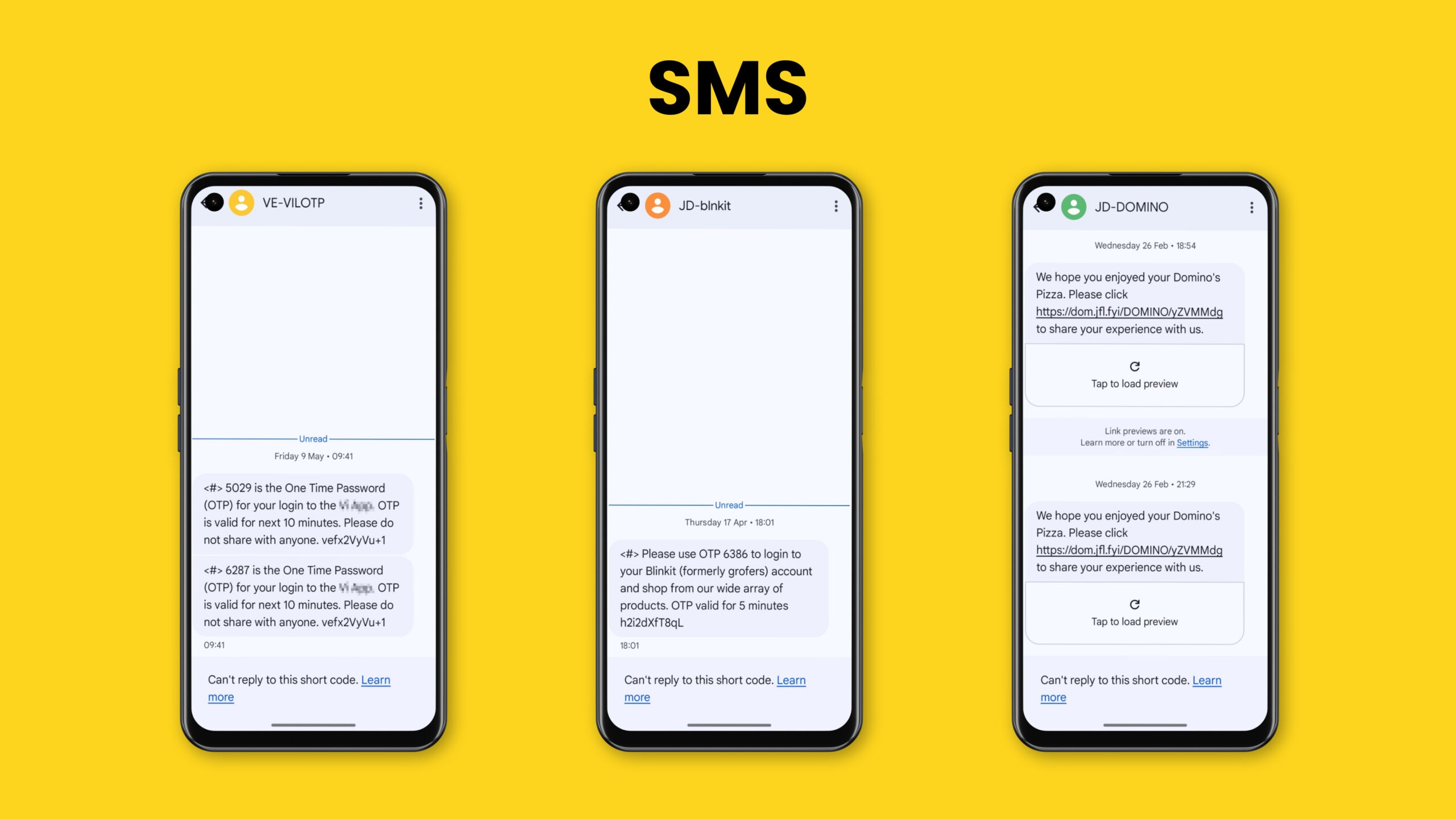
What is SMS?
SMS (Short Message Service) has been the foundation of mobile messaging for over 30 years—and it continues to hold its ground. Nearly every mobile phone in the world supports SMS, making it the most universal communication channel available today. No apps, no internet, no fancy tech—just a dependable text message that works anywhere, anytime.
That’s exactly why businesses still rely on SMS in 2025. Whether it’s sending appointment reminders, OTPs, alerts, or updates, SMS ensures your message reaches the customer, even when they’re offline or using a basic device.
In fact, 83% of consumers still say texting is their top mobile activity, surpassing even social media and email. For sheer reach and delivery reliability, SMS remains unmatched.
There’s also MMS (Multimedia Messaging Service), a slight upgrade to SMS that allows sending photos, videos, and audio files. But even with those features, MMS lacks the interactivity and visual polish offered by newer messaging platforms like RCS, WhatsApp, or Messenger.
While SMS does support basic two-way communication—like replies to messages from short or long codes—its capabilities are quite limited. There are no read receipts, no buttons, no typing indicators, and no branding options. It’s functional, but not flexible.
Still, in many situations, SMS serves as a critical fallback—especially when RCS isn’t available or supported by the user’s device or network.
In short, SMS may not be the flashiest tool in your messaging kit anymore, but it’s still a must-have for reach, reliability, and compatibility. And when paired with more modern options like RCS, it helps form a complete mobile messaging strategy.
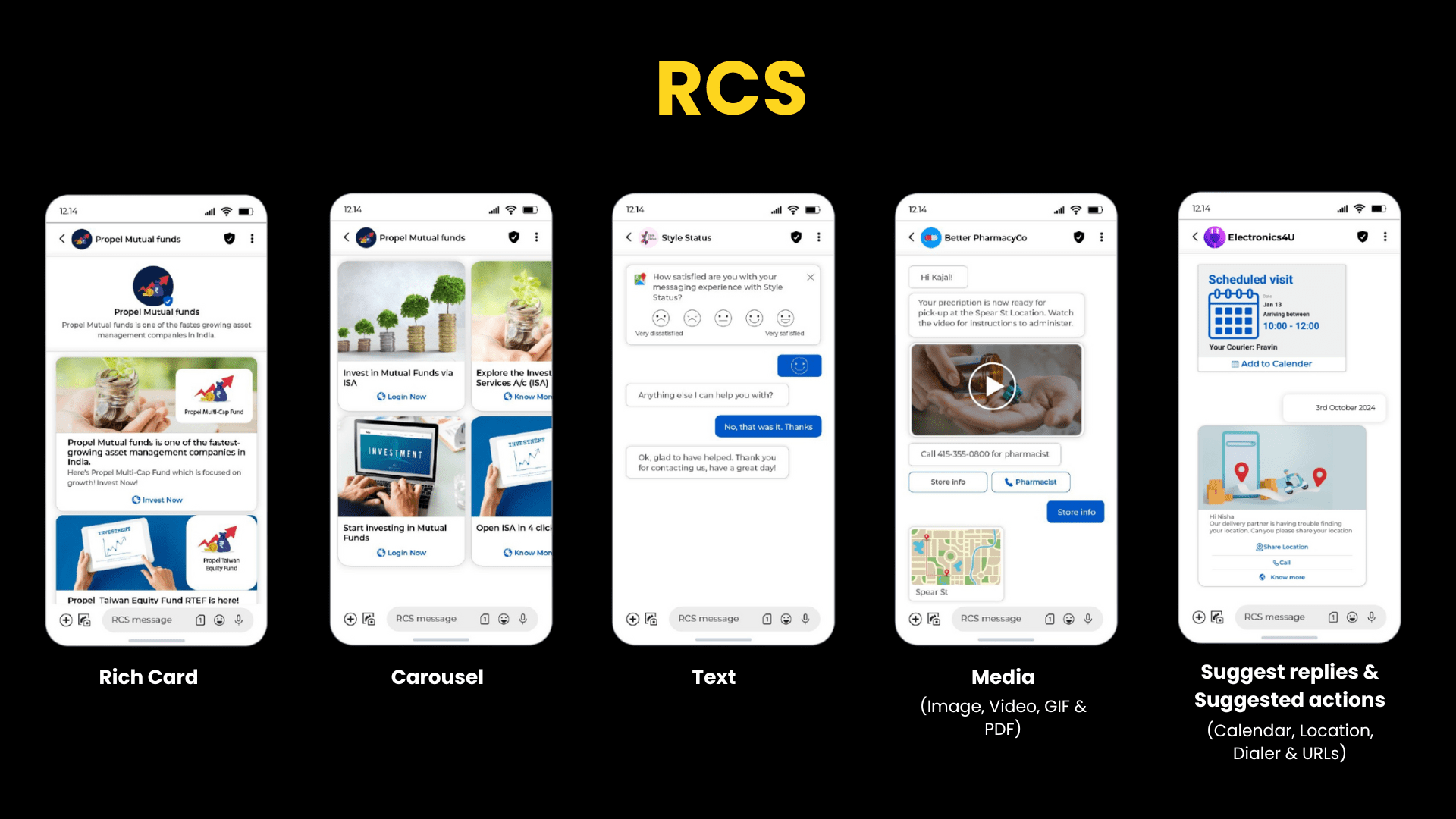
What is RCS?
RCS (Rich Communication Services) is the next-generation messaging protocol that upgrades traditional SMS with a modern, interactive experience. Think of it as bringing the best of apps like iMessage, WhatsApp, or Messenger—but directly into your phone’s default messaging app.
With RCS, users can send high-resolution images and videos, see when someone is typing, receive read receipts, tap on quick reply buttons, and even interact with carousels or forms—all within the native messaging inbox.
Unlike over-the-top (OTT) messaging apps, RCS doesn’t require downloading anything extra. It works right out of the box on supported Android phones—and now, with Apple slowly rolling out RCS support, it’s set to become a universal rich messaging standard for both platforms.
For users, RCS means conversations feel more fluid, engaging, and app-like. For businesses, RCS unlocks a new level of customer interaction—with branded messages, verified sender profiles, and interactive calls-to-action that drive real results.
And the impact is already being felt:
Over 51% of consumers in 2024 said they’re more likely to engage with an RCS message than a traditional SMS.
In simple terms, RCS is what SMS would look like if it were invented today. It’s visual, conversational, and built for the way people communicate now—making it one of the most powerful messaging tools available for forward-thinking brands.
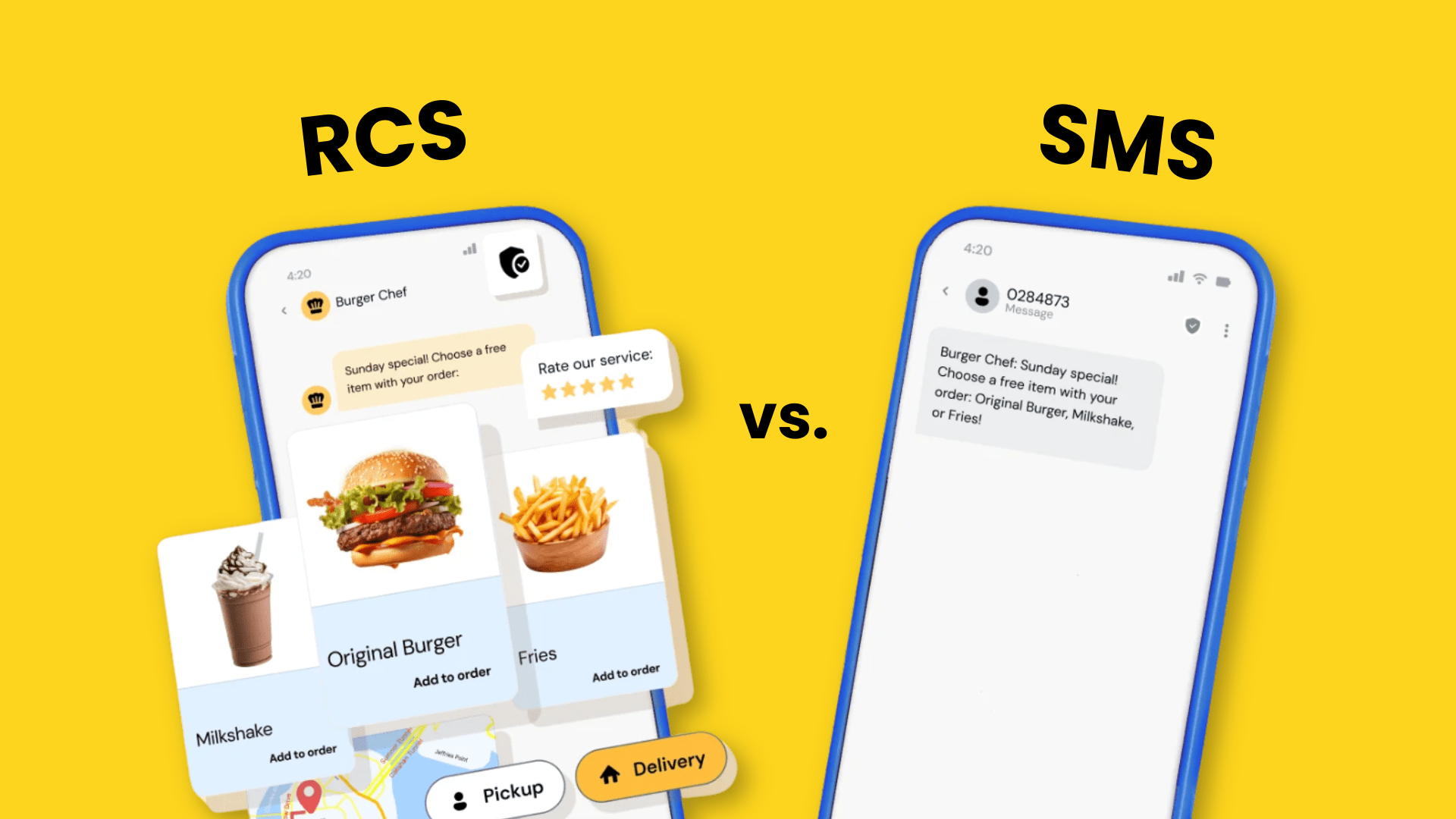
RCS vs SMS: What’s the Difference?
When it comes to business messaging in 2025, the choice between SMS and RCS isn’t just about how a message is sent—it’s about the kind of experience you want to deliver.
While SMS remains the most universally supported messaging method (working on virtually every phone, no internet required), RCS takes messaging to a whole new level with interactive, branded, and rich media experiences.
Here’s a clear comparison to help you understand how they stack up:
| Feature | RCS | SMS |
|---|---|---|
| Usability | Works on Android & iOS 18+; no third-party app needed | Works on all phones; no app required |
| Network | Requires mobile data or Wi-Fi | Uses cellular signal; no internet needed |
| Reach / Adoption | 1.5B+ Android users; growing with Apple support | 7.3B+ global mobile phone users |
| Text Limit | Up to 3,072 characters | 160 characters |
| Media Support | Images, carousels, buttons, maps, videos, audio | Plain text only (MMS allows limited media) |
| Security / Encryption | Encrypted in transit; end-to-end on Android | No encryption |
| User Experience | Branded, rich content with interactive UI | Basic plain text interface |
| Engagement | 90% read in 15 mins; longer interaction time | 90%+ open rate; shorter engagement |
| Branding | Verified sender name, logo, colors | No branding; Alpha Sender ID in few regions |
| Cost | Typically higher; may be session or event-based | Lower; per message or per segment |
| Compliance | Follows modern privacy laws; opt-in based | Strict opt-in required under TCPA, GDPR |
| Analytics | Read receipts, clicks, button usage, delivery | Only delivery status in most cases |
| Speed | Fast over data; reliable with internet access | Instant via cellular network |
| API Integration | Supports advanced API with cards, buttons; easy to integrate | Limited APIs (REST/SMPP); difficult to integrate |
| Global Availability | Expanding quickly with Android & iOS 18 | Universal compatibility across all regions |
As you can see, RCS and SMS differ widely in capabilities, security, and business use. Choosing the right one depends on your messaging goals, audience, and feature needs.
Is SMS or RCS Better for your Businesses?
The choice between SMS and RCS for the businesses depends entirely on your campaign goals and your target audience.
- SMS remains one of the most reliable and widely adopted messaging solutions, reaching almost any mobile phone on the planet—no internet needed.
- On the other hand, RCS messaging offers a richer, branded, and interactive experience, ideal for modern marketing needs.
In fact, the 2024 Customer Connections Survey revealed a growing frustration among users with generic, text-only messages. Consumers now expect:
- Two-way communication
- Fast responses
- Visual content that Result in CTA
So, what should your business choose?
Use RCS  If You Want:
If You Want:
- To send rich media like images, GIFs, carousels, maps, and videos
- Features such as read receipts, typing indicators, and longer message limits
- Branded messaging with logos, color themes, and verified sender names
- Higher engagement rates and visually-driven conversations
- AI-powered interaction or chatbot flows
Use SMS  If You Want:
If You Want:
- To ensure universal reach, including on basic or older mobile phones
- To send short, urgent, and text-only messages (e.g., OTPs, alerts)
- A fallback option when RCS isn’t supported
- A proven, cost-effective messaging method with a near-100% delivery rate
What Can SMS vs RCS Offer Your Business?
There’s no single “best” messaging channel for every business—and that’s actually a strength.
Many companies today use a hybrid strategy, leveraging both SMS and RCS to maximize reach and engagement. Here’s how:
| Use Case | SMS | RCS |
|---|---|---|
| Appointment Reminders | ✔ | ✔ (with visuals, maps) |
| Promotions/Offers | ✔ | ✔ (with buttons, rich cards) |
| Surveys & Feedback | ✔ | ✔ (interactive UI) |
| Customer Support | ✔ (basic replies) | ✔ (two-way chat with quick reply buttons) |
| Brand Awareness | ✖ | ✔ (branding, logos, themes) |
Pro Tip: Use Auto-Fallback
The smartest approach is to integrate an API that supports both SMS and RCS. This allows your system to:
- Automatically upgrade to RCS when supported
- Fallback to SMS when needed
This ensures that your message is always delivered, in the best possible format, without additional work.
What is RCS Messaging? How to Get Started in 2025
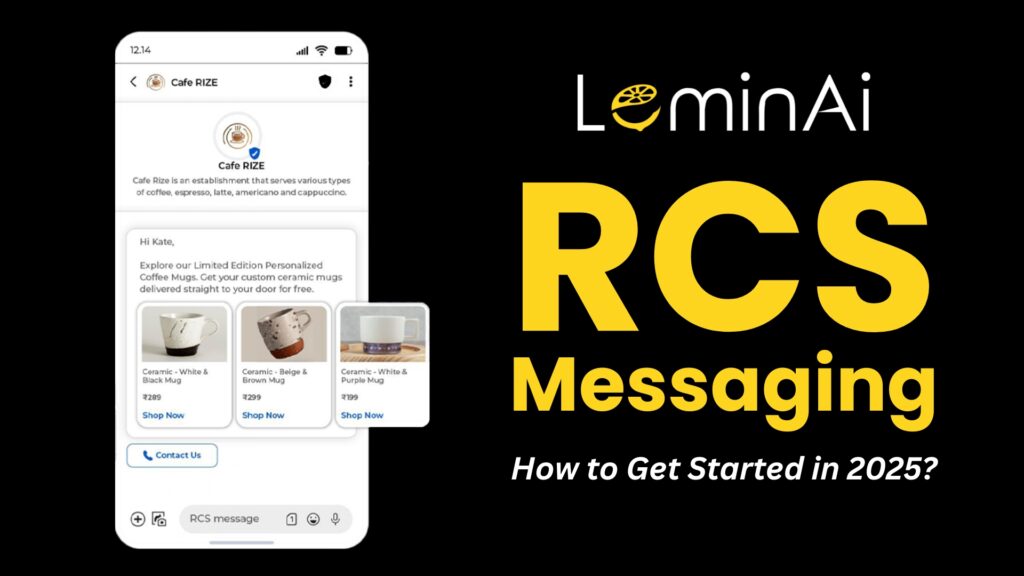
SMS just got a major UPDATE!
Say hello 👋 to RCS Messaging by LeminAi, powered by Google.
No more boring texts — now send rich, interactive messages with stunning images, videos, carousels, and clickable buttons. All branded with your logo and name, right inside your customer’s SMS inbox.
This isn’t just messaging. It’s conversational magic. Turn conversations into conversions.
When we think of mobile messaging, the first thing that comes to mind is SMS — the simple text messages we’ve been using since the 1990s. They’ve served us well over the years, especially with their high open rates. But let’s face it — in today’s world of smartphones, emojis, apps, and instant media, plain text feels outdated. So, what is RCS Message? RCS (Rich Communication Services) is the next-generation messaging protocol designed to replace SMS by offering features like read receipts, typing indicators, high-resolution media sharing, and more interactive communication.
That’s where RCS Business Message, or Rich Communication Services, steps in.
Originally developed by the GSM Association (GSMA) and launched in 2008, RCS was designed to give messaging a much-needed upgrade. It brings the kind of features you’d expect from modern apps like WhatsApp or iMessage — but it does all this inside your default phone messaging app. No separate app required.
With RCS messaging, users can send high-quality images and videos, see when someone is typing, get read receipts, and interact with buttons and carousels — all from the same app where they’d normally send an SMS. It’s messaging built for the smartphone age.
And businesses are taking notice. Over 800 million people now use RCS monthly, and companies are using it to create richer, more engaging customer experiences. Brands can add verified sender IDs, use scrollable product cards, and send clickable call-to-action (CTA) buttons — turning a simple message into a mini customer journey.
So, what does this mean for your business?
It means you can now connect with customers in a smarter, more personalized way — using the inbox they already trust. RCS doesn’t just send a message; it starts a conversation that can build trust, improve engagement, and drive action.
In this article, we’ll explore everything you need to know about RCS — what it is, how it works, how it compares to SMS, and why it’s quickly becoming the future of mobile communication for businesses.
What is RCS Message?
RCS, or Rich Communication Services, is the next step in the evolution of mobile messaging. Think of it as SMS on steroids — a modern messaging protocol designed to make texting more interactive, engaging, and useful for both everyday users and businesses.
Unlike traditional SMS, which limits messages to 160 characters and only allows basic text, or MMS, which supports simple media like pictures and videos but with limited features, RCS opens up a whole new world. It lets you send high-resolution images and videos, share interactive content like product carousels or quick reply buttons, and even see real-time typing and read indicators — all directly inside your phone’s default messaging app. There’s no need for third-party apps like WhatsApp or Facebook Messenger.
For businesses:
RCS is a game-changer. It allows brands to send branded, verified messages that build trust and look professional. Whether it’s customer support chats, order updates with maps, or interactive marketing campaigns, RCS helps companies connect with customers in a way that feels personal and seamless. Plus, since it works right inside the native messaging app, customers don’t have to download anything extra, reducing barriers to communication.
With over 1.5 billion users worldwide in 2025 and growing support from carriers and smartphone makers like Apple and Android, RCS is quickly becoming the future of mobile messaging — richer, smarter, and more connected than ever before.
For users:
RCS feels like texting — but way better. Instead of boring, plain text messages, you get a richer experience that feels more like chatting on popular apps like WhatsApp or iMessage.
Here’s what you’ll notice: when you’re chatting with friends or businesses, you can see when they’re typing, when your messages have been read, and even send or receive large, clear photos and videos without hassle. You might get helpful buttons right inside the message, like quick replies or options to track a package, book an appointment, or browse products — all without opening another app.
Since RCS works inside your phone’s regular messaging app, you don’t have to switch apps or download anything new. It’s all seamless, making your conversations smoother, faster, and more fun. Whether you’re catching up with family or getting updates from your favorite stores, RCS makes messaging feel more alive and interactive.
What is SMS?
SMS (Short Message Service) is the original text messaging format introduced in the 1990s. It allows for:
- Up to 160 text characters
- Delivery receipts at best
- No images, buttons, or sender verification
While SMS works universally on all phones, it lacks engagement features and fails to deliver modern messaging experiences.
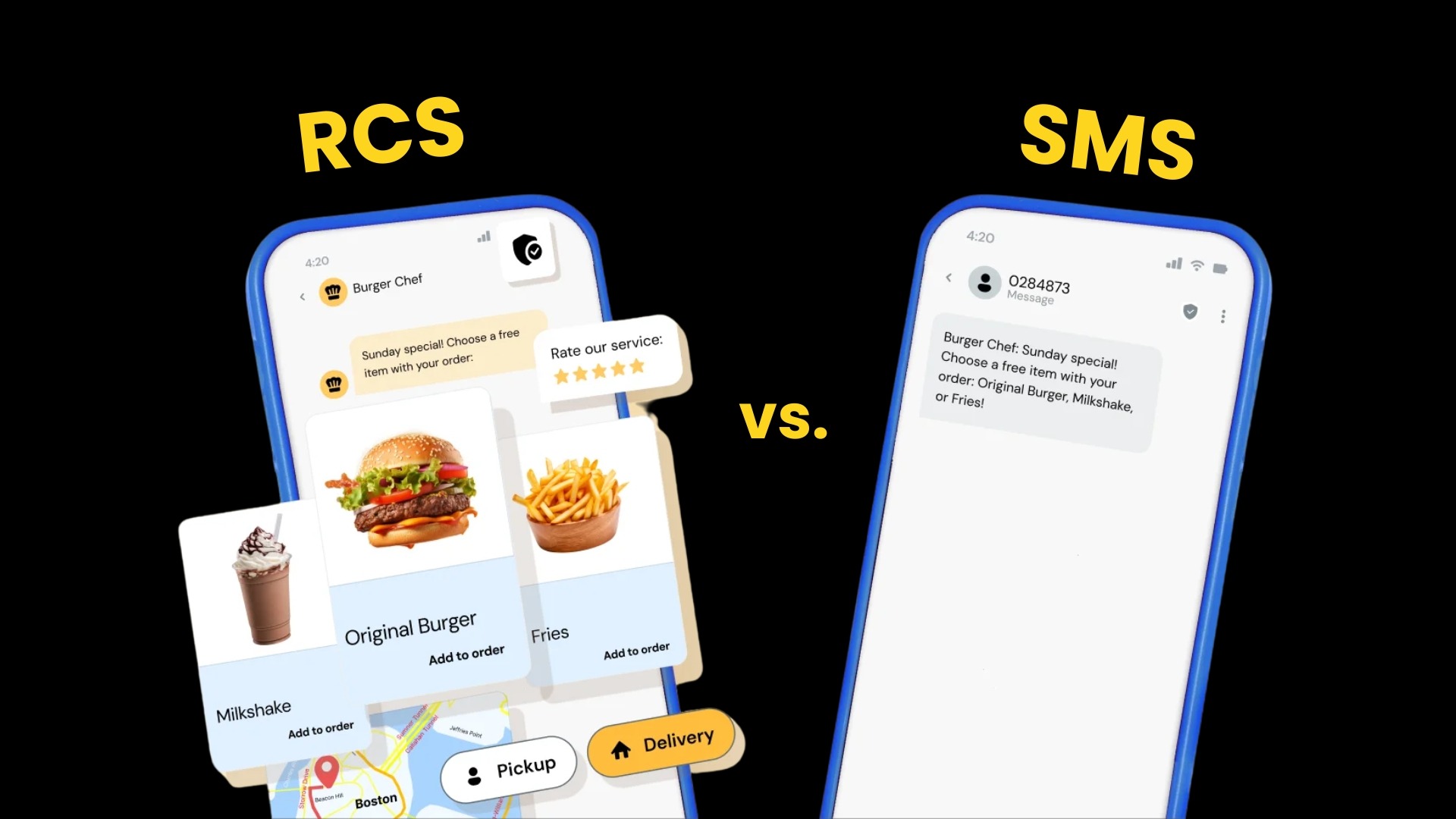
| Feature | RCS (Rich Communication Services) | SMS/MMS |
|---|---|---|
| Character Limit | 3072 characters | 160 characters (SMS) |
| Media Sharing | High-resolution images, videos, GIFs | Basic media via MMS, limited quality |
| Read Receipts | Supported | Not supported |
| Security | End-to-end encryption (varies) | No encryption, messages can be intercepted |
| Verification | Verified sender profiles to reduce spam | No sender verification |
| Compatibility | Available on Android; iOS support evolving | Universal compatibility |
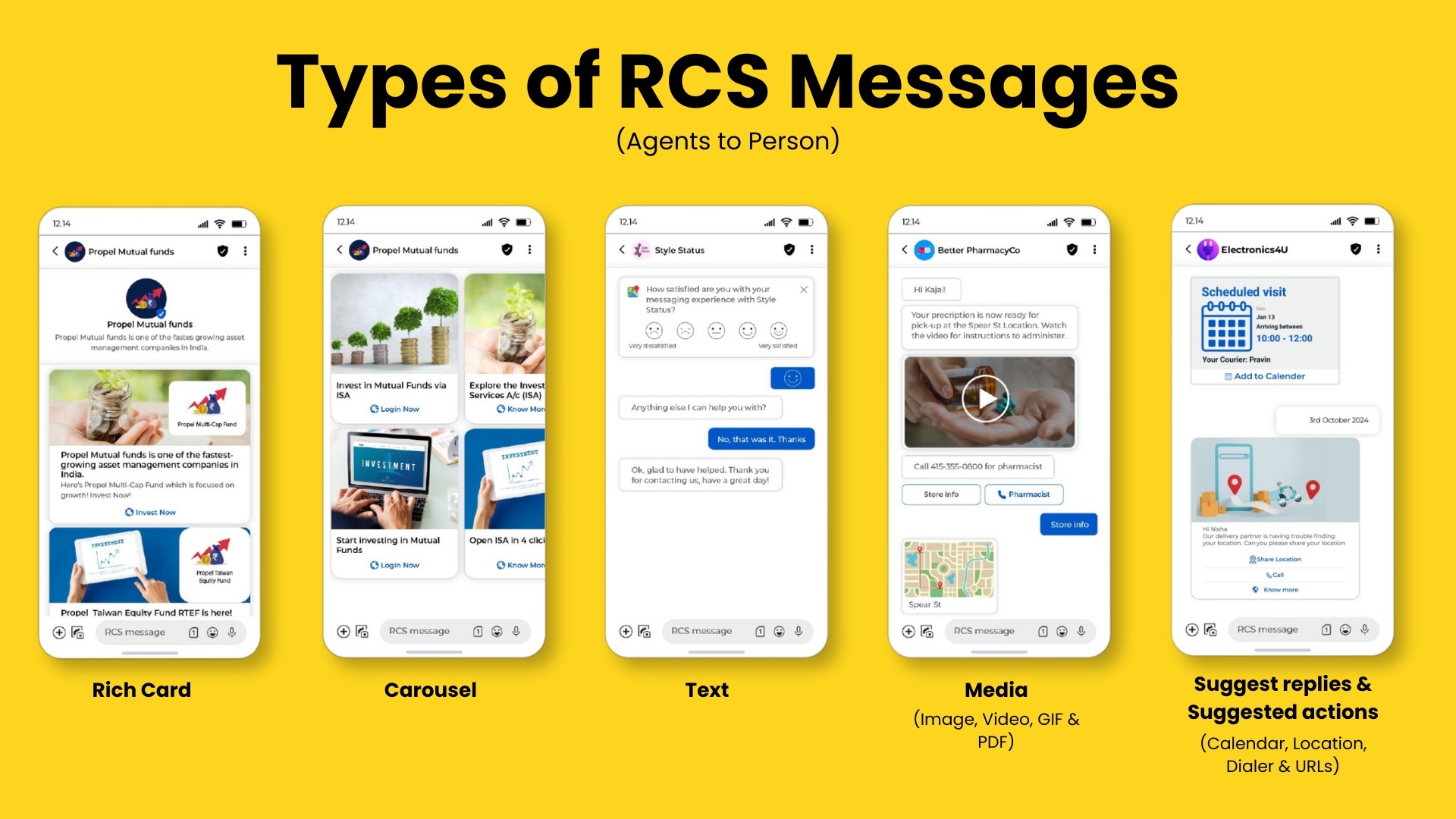
Types of RCS Messages (Short Overview)
RCS (Rich Communication Services) goes beyond plain text by offering rich, interactive messaging formats. Let’s take a quick look at the two primary types of RCS messages businesses can use — and what users can do in return.
Agent-to-Person (A2P) Messages
These are messages sent from businesses to users. They offer advanced formats and functions:
- Basic Text: Short text-only message (≤160 characters), no buttons or media
- Single Rich Message: Text exceeding 160 characters or containing media (images, videos), often with suggested replies or action buttons
- Rich Carousel / Card Message: Scrollable carousel of interactive cards (up to 10), each with images, titles, and buttons
Each of these offers a richer, app-like messaging experience right within your SMS inbox.
Person → Agent (User-Initiated)
- Free‑form Text or Media Response: Users can reply with text, links, images, emojis, or even location sharing.
- Quick-Reply/Button Response: Tapping a suggested reply or CTA (e.g., “Track Order”, “Yes”, “Cancel”) triggers an instant response to the business agent
Want to dive deeper into message formats, use cases, and technical specs?
Click here to read our detailed blog on RCS message types
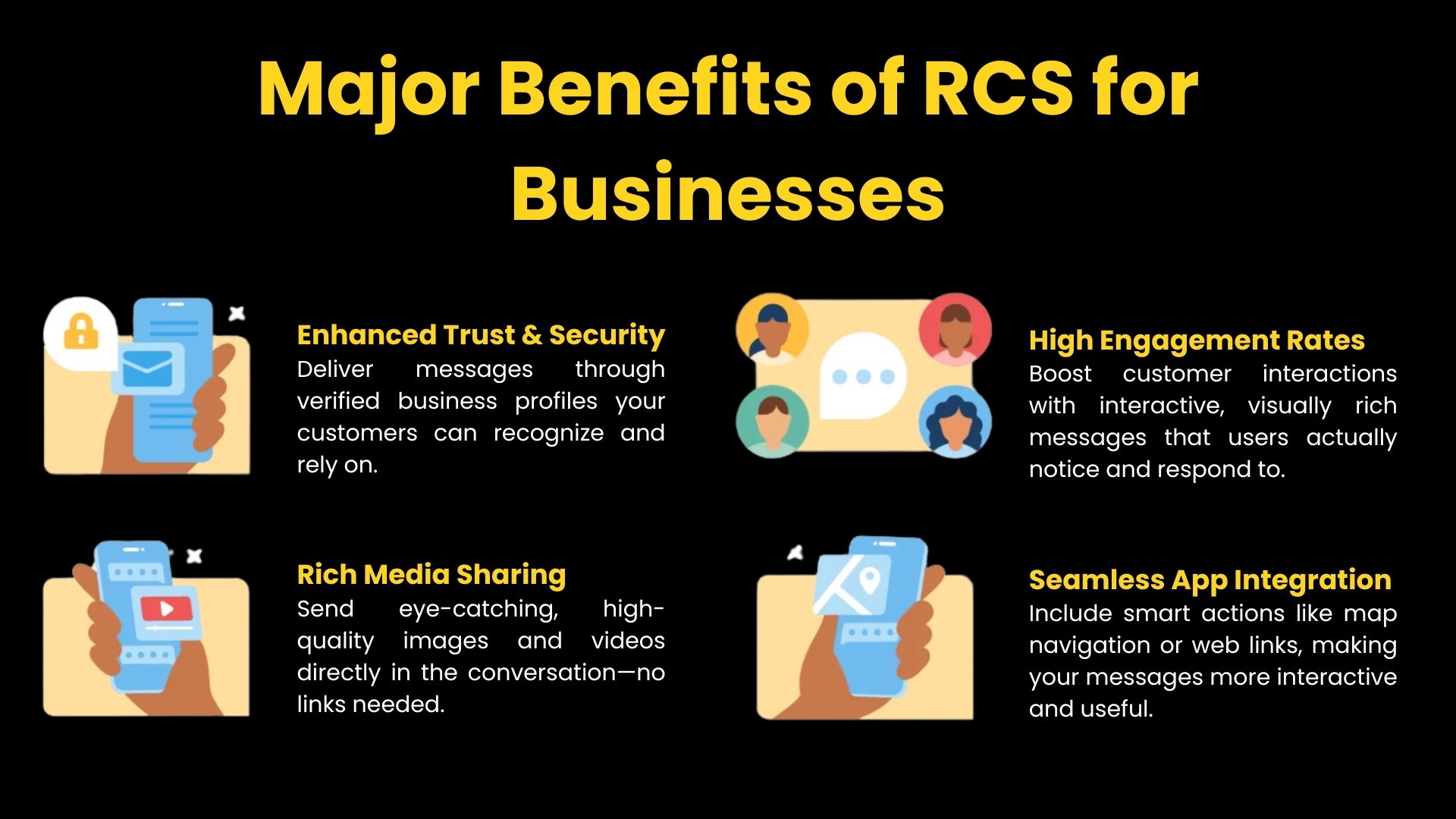
Major Benefits of RCS Message for Businesses and Consumers
RCS messaging is changing how we connect—making conversations more interactive, engaging, and trustworthy. Whether you’re a brand trying to reach your audience or a consumer looking for smoother communication, RCS has something valuable for everyone.
Benefits of RCS for Businesses
Stronger Branding & Trust
RCS lets businesses send messages with their brand name, logo, and colors—right inside the messaging app. No more generic “unknown numbers.” This builds instant recognition and makes your messages feel official and secure.
Rich, Interactive Messaging
Share high-quality images, videos, GIFs, product carousels, and more. With clickable buttons like Buy Now or Track Order, you can turn a simple message into a full customer experience—without sending users to a separate app or website.
Better Customer Engagement
Thanks to its visual appeal and interactive elements, RCS tends to get higher open and response rates than regular SMS. Customers are more likely to read, interact with, and even buy from a well-crafted RCS message.
Smart Analytics & Delivery Tracking
With RCS, you get delivery reports, read receipts, and interaction tracking. This means you can see what’s working, what’s not, and tweak your campaigns accordingly—something SMS never offered.
App-like Experience Without the App
RCS gives you the power to deliver app-like experiences—menus, FAQs, forms, confirmations—directly inside the user’s messaging inbox. This reduces friction and increases conversions, especially in regions where mobile app usage is low.
Verified Sender Identity
Your messages appear from a verified business profile, reducing the risk of fraud and increasing trust. Customers are more likely to engage when they know it’s really you.
Benefits of RCS Message for Consumers
More Enjoyable Conversations
No more plain texts. RCS supports high-res images, videos, audio, and interactive messages. Whether you’re chatting with a friend or a brand, everything just looks and feels better.
Helpful Read & Typing Indicators
See when your message is delivered, read, or when someone’s typing a reply—just like popular messaging apps. It makes conversations feel more real-time and natural.
Group Chats That Actually Work
RCS improves group messaging with better message syncing, delivery confirmation, and media support—great for coordinating with friends or teams.
Smarter Interactions with Brands
Want to check your delivery status or book an appointment? With RCS, you can do it directly from your message thread—no need to download a separate app or make a phone call.
Enhanced Privacy (Optional)
Many RCS services support end-to-end encryption, adding an extra layer of security to your chats. You stay in control of your data and conversations.
Works Across Devices
RCS is now supported on most Android devices and is gradually expanding across platforms, including Apple. That means richer messaging that just works—no matter what phone you’re using.
RCS is more than just messaging. It’s a complete communication upgrade—for businesses looking to connect better and for customers who expect more from every conversation.
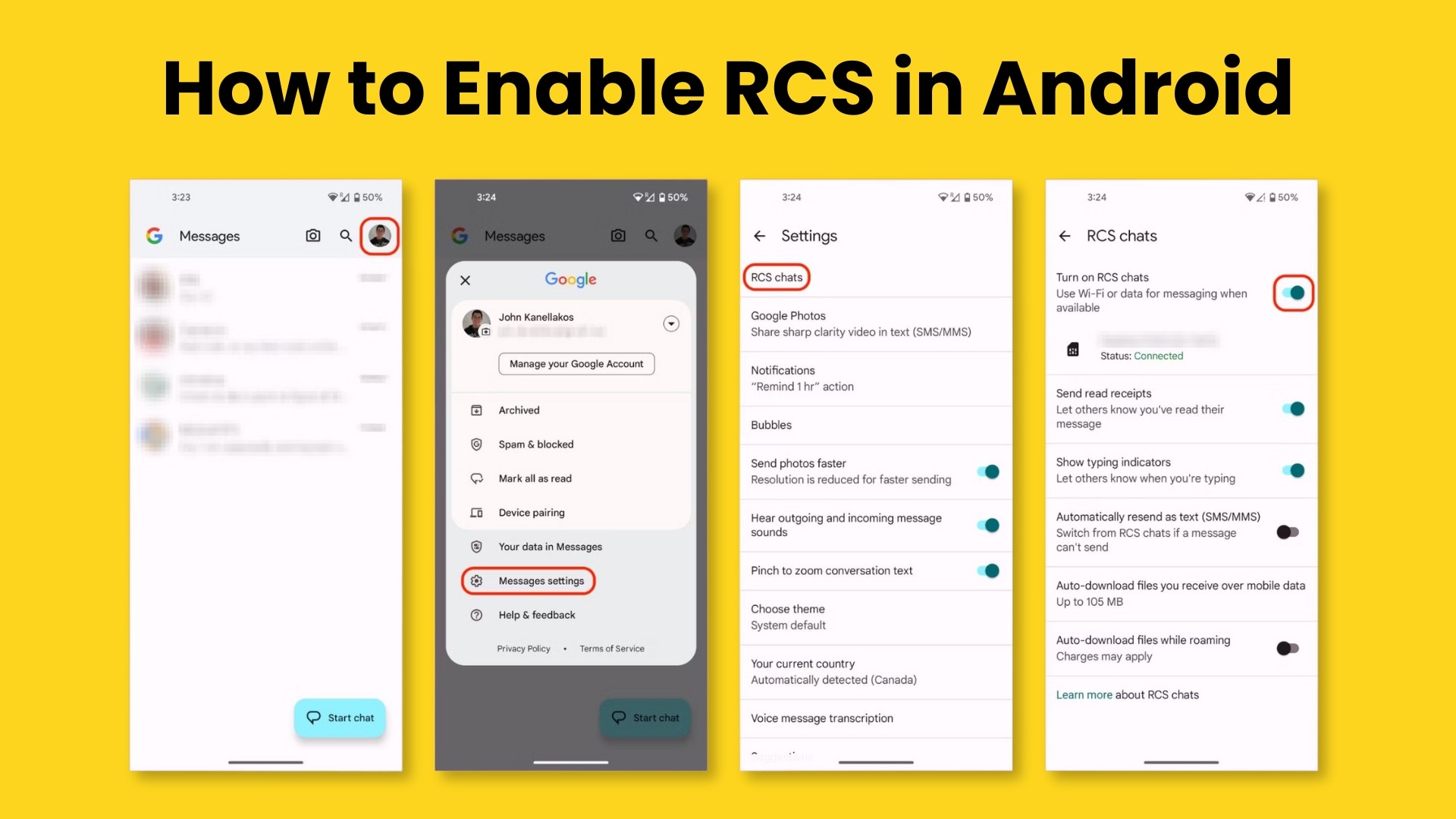
How to Enable RCS Message in Android?
Most Android phones with Google Messages support RCS. To enable:
- On your device, open Google Messages
- At the top right, tap your profile picture or icon and then Messages settings.
- Tap RCS chats.
- Turn RCS chats ON
Tips:
- If you can’t find “RCS chats,” tap Chat features.
- If you’re not connected, tap Verify your number.
Once on, messages auto-upgrade to RCS when possible
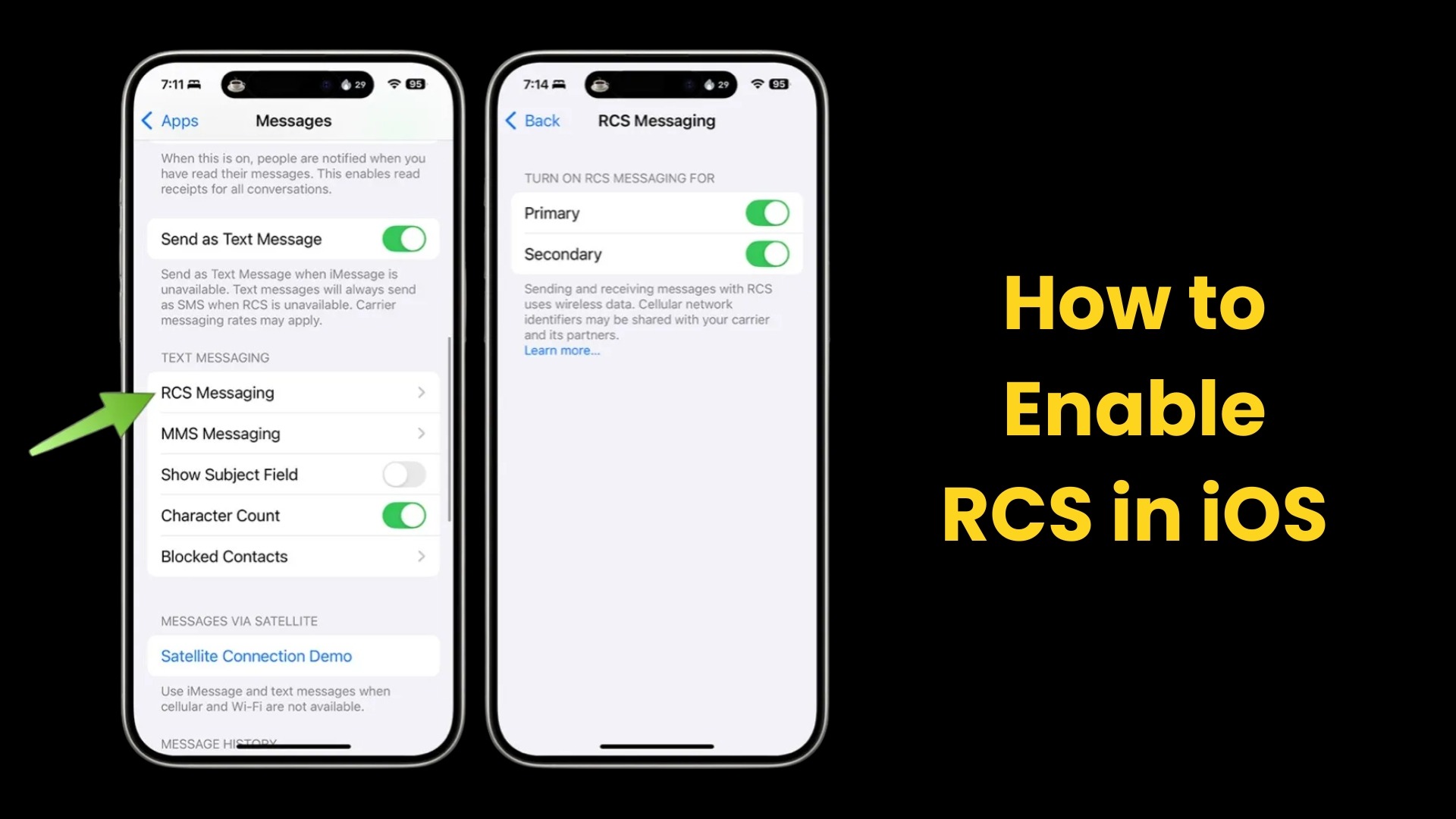
How to Enable RCS Message in iOS?
Apple added support in iOS 18 (launched September 2024) with more features rolling out in iOS 18.1+ . To enable:
- Go to Settings → Messages
- Turn on RCS Messaging (iOS 18+)
How RCS Messaging Can Grow Your Business in 2025?
RCS (Rich Communication Services) is more than just the next step in text messaging—it’s a marketing and customer experience game-changer. Whether you’re a retail brand, service provider, or event organizer, RCS lets you meet your customers where they are: their messaging inbox. And unlike traditional SMS, it brings media-rich features that make every interaction feel personalized, smart, and useful.
Let’s explore how RCS helps both businesses thrive and customers enjoy a better experience.
Smarter Promotions and Campaigns
Tired of plain-text messages getting lost in the noise? RCS allows businesses to create stunning, interactive campaigns with images, videos, QR codes, and even carousels. That means you can showcase products, offer discounts, and direct users to purchase—all within the messaging app.
Example: A fashion brand can send a mini product catalog where customers can swipe through styles and tap to shop instantly.
Personalized Customer Journeys
RCS isn’t just a broadcast tool—it’s conversational. You can tailor messages based on your customer’s history, preferences, and behavior. Whether it’s suggesting items based on past orders or recommending services in a specific area, RCS makes personalization easy and effective.
Did you know? A 2024 BFCM survey showed that nearly 80% of consumers value personalized messages. With RCS, personalization doesn’t feel automated—it feels like a genuine conversation.
Real-Time Updates & Alerts
From delivery notifications to appointment reminders, RCS makes real-time updates feel seamless. It supports interactive buttons, directions, and live support—all within the chat. Customers can confirm bookings, reschedule appointments, or track orders without opening another app.
Case in point: EasyPark uses RCS for live parking alerts, including their branding and verified profile, increasing trust and user interaction.
Verified & Trusted Communication
No more guessing if the message is real. With RCS, you get verified business profiles, complete with brand logos, colors, and contact details. This helps reduce fraud and increases the likelihood that customers will engage with your message.
Higher Engagement, Better Conversions
Because RCS messages are visually rich and interactive, businesses report higher read and response rates than with SMS. Add to that the ability to track delivery, clicks, and replies in real-time, and you’ve got a powerful channel for increasing ROI.
Cost-Effective Customer Support
RCS supports AI chatbots and live agents, which means you can handle queries, complaints, and even post-sale support in one place. It streamlines the entire support journey—from image sharing for product issues to interactive video guides for troubleshooting.
Is Your Brand Ready for RCS in 2025?
As we move deeper into 2025, customer expectations are changing—and fast. People want conversations, not just messages. They want experiences, not just notifications.
RCS is no longer just a future-ready solution; it’s a now-ready opportunity for businesses that want to stay ahead. But is your brand prepared to fully leverage it?
A Quick Readiness Checklist:
- Do your current campaigns feel limited by SMS constraints?
- Are you looking to improve how customers interact with your offers or services?
- Do you have a need for better customer insights and performance tracking?
- Are your support channels overloaded or lacking interactivity?
- Would a verified, branded messaging presence increase customer trust?
If you answered “YES” to even one of these, your brand is ready to explore RCS.
What’s Next?
Who Can Send RCS Messages?
Anyone who can receive RCS messages can send them too. The upgrade from SMS to RCS happens automatically in the background, giving people a richer, more modern messaging experience without them needing to do anything.
For businesses that want to send RCS messages—like appointment reminders, updates, or promotions—they’ll need to go through a communications platform that supports RCS. That’s where LeminAi comes in. LeminAi makes it simple by integrating RCS directly into the messaging tools you’re already using. There’s no need to switch APIs or rebuild your messaging system from scratch—just tap into the richer features of RCS with minimal effort.
As RCS continues to roll out around the world, more mobile carriers are jumping on board, which means businesses using platforms like LeminAi can reach more people with interactive, high-quality messaging than ever before.
Wati vs. AiSensy vs. Interakt vs. DoubleTick vs. Gallabox
What is WhatsApp Business API?
WhatsApp Business API has revolutionized customer communication, allowing businesses to send bulk messages, automate replies, and enhance engagement. With multiple providers offering API services, choosing the right one can be confusing. Below, we compare the top WhatsApp Business API providers (wati vs. aisensy vs. Interakt vs. DoubleTick vs. Gallabox) based on pricing, chatbot features, and other key aspects.
WhatsApp Business API Providers Comparison
The table below highlights the differences between popular WhatsApp Business API providers, helping you make an informed decision.
| Feature | LeminAi | Wati | AISensy | Interakt | DoubleTick | Gallabox |
|---|---|---|---|---|---|---|
| Conversation Billing from Meta | Yes | No | No | No | No | No |
| Basic Monthly Subscription | 599 | 4499 | 999 | 1499 | 2500 | 799 |
| Premium Monthly Subscription | 999 | 13499 | 2399 | 4399 | 3500 | 2399 |
| Chatbot | Free Unlimited | Free Unlimited | 1999 for 5 Chatbots | 6 | Free Unlimited | Free Unlimited |
| No. of Agents | Unlimited | 5 | Unlimited | Unlimited | 10 | 6 |
| Smart Analytics | Yes | No | No | No | Yes | Yes |
| Marketing Message Cost (including GST) | 0.83 | 1.12 | 1.04 | 1.04 | 1.05 | 1.11 |
| Technical Support | Call, Email & Chat | Email & Chat | Chat | Chat | ||
| Add Notes | Yes | Yes | No | No | No | No |
| Quick Reply | Text, Button/ Multimedia | Text | Text | Text | Text | Text |
| Chatbot (Non-Template) | Text, Button/ Multimedia | Text | Text | Text | Text | Text |
| Chat Link & QR Generator | Yes | Yes | Yes | Yes | No | No |
| Free Trial Days | 15 | 7 | 14 | 14 | No | No |
Key Takeaways from the Comparison
When choosing a WhatsApp Business API provider, businesses must consider key factors such as pricing, features, chatbot capabilities, and customer support. Among all available options, LeminAi emerges as the most cost-effective and feature-rich solution. Let’s break down how LeminAi outperforms competitors like Wati, AiSensy, Interakt, DoubleTick, and Gallabox across crucial parameters.
Conversation Billing from Meta
Most API providers operate on a prepaid model, requiring businesses to pay upfront for conversation charges. This locks their funds before actual usage. LeminAi is the only provider that directly onboards customers with Meta, allowing them to be billed periodically rather than making advance payments. This flexibility ensures better cash flow management for businesses.
Try WhatsApp Official for FREE! Sign up now and enjoy a 15-day trial—no commitment required!
Basic Monthly Subscription
This is the entry-level plan covering essential messaging and automation features. LeminAi offers the lowest starting price of ₹599, significantly cheaper than competitors like Wati (₹4,499) and DoubleTick (₹2,500).
Premium Monthly Subscription
Higher-tier plans include advanced features like analytics, multiple integrations, and priority support for businesses needing more functionality. LeminAi provides premium features at just ₹999, whereas others charge much higher—Wati at ₹13,499, AiSensy at ₹2,399, and Interakt at ₹4,399.
Free Unlimited Chatbots
Many providers impose extra charges for chatbots, restricting automation. For instance, AiSensy charges ₹1,999 for 5 chatbots and ₹750 per additional chatbot. In contrast, LeminAi provides unlimited chatbots for free, allowing businesses to automate customer interactions without any extra cost.
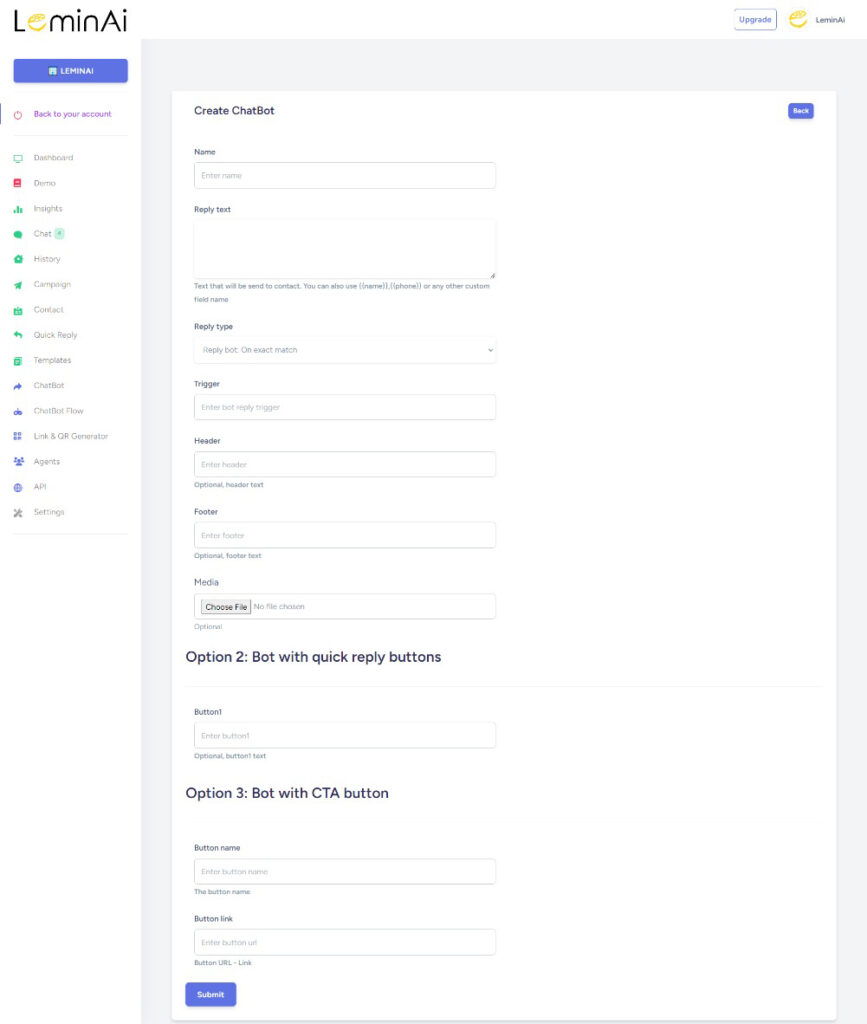
Unlimited Agents for Seamless Team Collaboration
The number of agents determines how many human support staff can simultaneously log into the dashboard to manage customer chats. Most providers impose limits—Wati allows only 5 agents, DoubleTick 10, and Gallabox 6. However, LeminAi stands out by offering unlimited agents, making it the perfect choice for businesses with large customer support teams.
Boost Your Business with WhatsApp Official. Get a 15-day free trial & connect with customers like never before
Advanced Smart Analytics
Advanced analytics help track message delivery, customer interactions, and response rates, enabling data-driven decision-making. LeminAi delivers top-notch smart analytics to track message delivery, customer engagement, and response rates. Some competitors, including Wati, AiSensy, and Interakt, lack this feature, limiting insights for businesses.
Lowest Marketing Message Cost
LeminAi offers the most affordable marketing message cost in the industry at just ₹0.83 per message, structured as:
✅ Meta Charges: ₹0.78
✅ LeminAi Markup + GST: ₹0.05 (₹0.04 + 18% GST)
In comparison, other providers charge significantly higher rates and apply taxes on the entire bill amount:
✅ Wati: ₹1.12
✅ AiSensy: ₹1.04
✅ Interakt: ₹1.04
✅ DoubleTick: ₹1.05
✅ Gallabox: ₹1.11
By choosing LeminAi, businesses can save up to 35% on messaging costs, making it the most cost-effective solution in the market.
Technical Support
Unlike competitors who provide limited support options, LeminAi offers support via Call, Email, and Chat.
- Wati, AiSensy, and Interakt only offer email support.
- DoubleTick and Gallabox provide chat support only, with no direct call support.
LeminAi ensures businesses get instant assistance whenever needed.
Add Notes
Only LeminAi & Wati providers allow agents to add notes to customer interactions for better context and follow-ups.
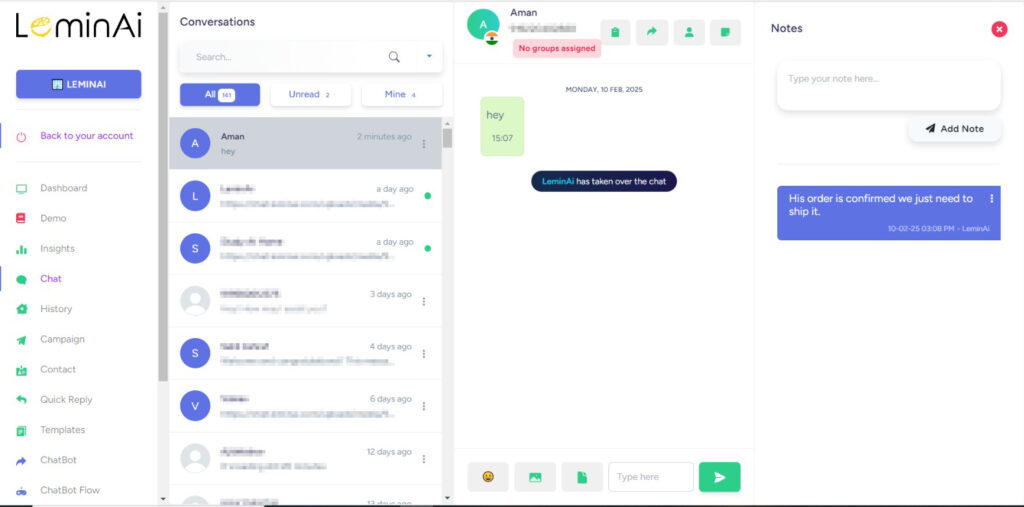
Quick Reply
This feature enables businesses to store and use pre-saved responses for faster replies to common queries. While other providers offer only text-based quick replies, LeminAi supports text, button-based, and multimedia quick replies, allowing for richer customer engage.
Start Your WhatsApp Official Trial Today! Experience powerful messaging tools with a 15-day free trial
Chatbot (Non-Template)
Non-template chatbots handle dynamic responses, unlike template-based ones that require WhatsApp approval. Unlike competitors who support only text-based non-template chatbots, LeminAi enables text, button-based, and multimedia chatbots for more interactive automation.
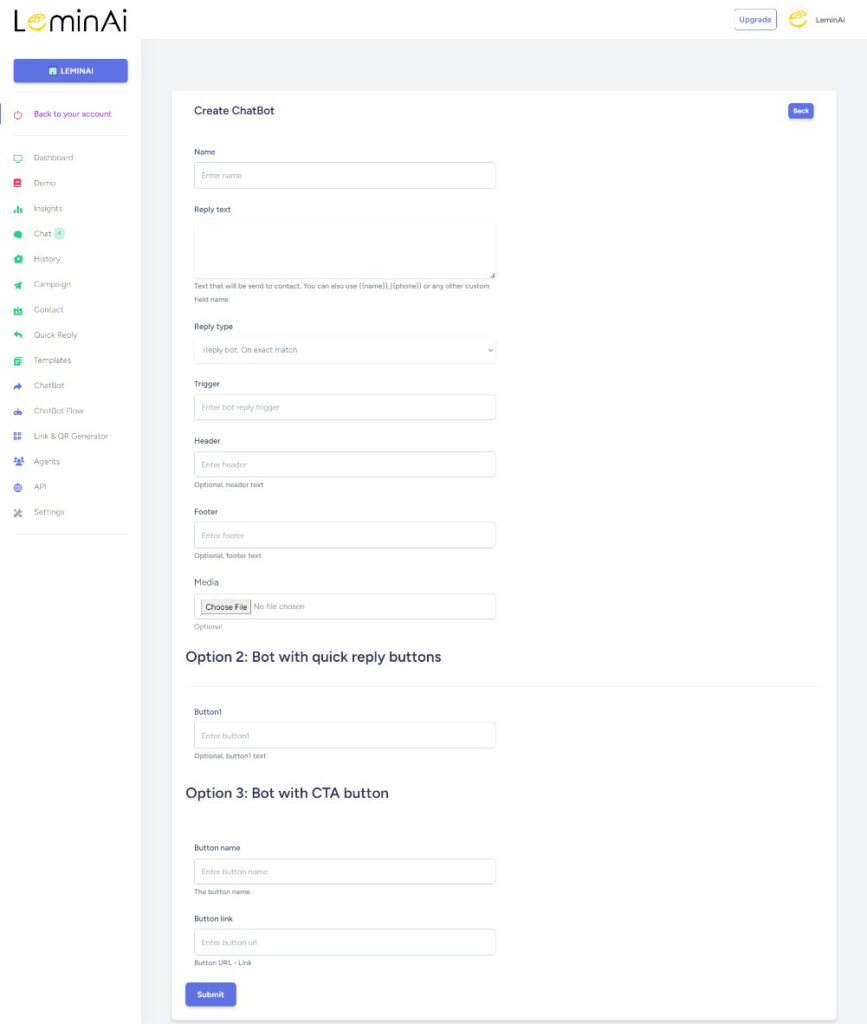
Chat Link & QR Generator
Businesses can create WhatsApp chat links or QR codes for customers to initiate conversations instantly. LeminAi, Wati & AiSensy allow businesses to generate WhatsApp chat links and QR codes, making it easier for customers to initiate conversations instantly.
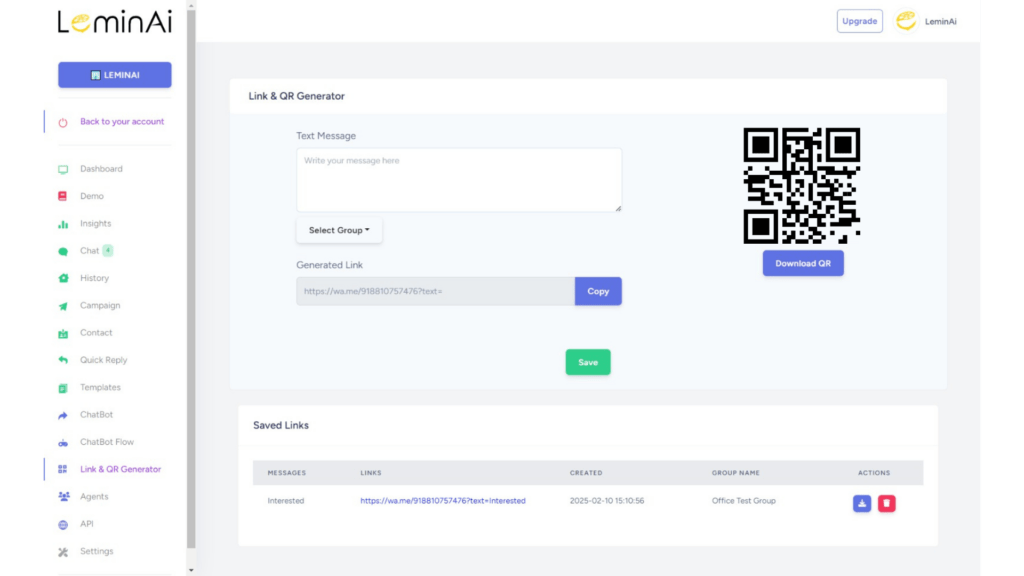
Best Free Trial Period
Most providers offer a 7 to 14-day trial, but LeminAi provides a full 15-day free trial, ensuring businesses have ample time to test features before committing.
How to Choose the Best WhatsApp API Provider?
When selecting a WhatsApp Business API provider, consider the following:
- Pricing & Transparency: Opt for a provider that offers cost-effective solutions with no hidden charges.
- Automation Features: Ensure the API supports chatbot automation, bulk messaging, and integrations with CRM tools.
- Customer Support: Reliable customer service ensures smooth operation and minimal downtime.
- Ease of Integration: Choose a provider with easy API documentation and plug-and-play solutions.
WhatsApp Official: Free for 15 Days! Sign up today and explore the best way to engage customers
Watch Video to Know more about WhatsApp Business API
Conclusion
Selecting the right WhatsApp Business API provider depends on your business needs. If affordability and transparency matter, LeminAi stands out as the best choice. For those seeking advanced automation, Interakt and DoubleTick provide robust solutions. Analyze your requirements and choose wisely.
🚀 Ready to Scale Your Business on WhatsApp? Get started with a trusted WhatsApp API provider today!
Let us know in the comments which provider you prefer and why!
WhatsApp Business API vs. WhatsApp Official vs. WhatsApp Virtual
Stuck between choosing WhatsApp Business API or WhatsApp Marketing – Personal or WhatsApp Marketing – Virtual for your business?
We cover everything for you! WhatsApp, with over 2.2 billion monthly global users, is one of the most popular messaging apps worldwide. Businesses can now use it to reach customers quickly and easily. Whether you run a small business or a large enterprise, WhatsApp has options that can suit your needs.
The WhatsApp Business API offers powerful tools for companies that need to handle a large volume of messages, automate interactions, and integrate with their CRM systems. However, If you prefer a more personal touch, WhatsApp Marketing through personal accounts might be your best option. Then there’s WhatsApp Marketing – Virtual, which is ideal for Bulk Marketing and Awareness Campaigns. In below table, we’ll help you compare these three “WhatsApp Business API Vs. WhatsApp Official Vs. WhatsApp Virtual” to decide which one will work best for your business.
WhatsApp Business API Vs. WhatsApp Official Vs. WhatsApp Virtual
| Factors | WhatsApp Business API | WhatsApp Official | WhatsApp Virtual |
|---|---|---|---|
| Messages Sent Via | Your Brand Name | Your WhatsApp Number. Your Brand Name if Meta Verified taken. |
Random Number |
| Account Type | Requires new or unused WhatsApp number | Uses existing WhatsApp number | No WhatsApp account required |
| Ideal Use Case | Bulk Broadcasting & Transactional Messages | Messaging to only known contact | Bulk Broadcasting |
| Blue Tick | Can be Applied | Can be Applied on WhatsApp Business App. Separate charges payable to Meta |
Not Applicable |
| Call to Action Button | Yes | No | No |
| Per-Message Cost | ₹0.11 (Utility), ₹0.78 (Marketing) | No per-message cost | ₹0.10 – ₹0.16 |
| To whom Message Cost is Paid | Meta (Parent Company of WhatsApp) & Markup to Platform Provider |
Not Applicable | Platform Provider |
| Platform Fee | Yes | Yes | No |
| Template Approval | Yes | No | No |
| Message Sending Limit | Unlimited | Unlimited | Unlimited |
| WhatsApp Banning | Not Possible | Only if Large number of Recipient Report or Block. Almost not possible if Meta Verified taken. | Doesn’t Matter as these are Random Numbers |
| Operation Time | 24 Hours (All Days) | 24 Hours (All Days) | 10 am – 6 pm (Mon – Sat) |
| Message Scheduling | Possible | Possible | Not Possible |
| Message with Variable | Possible | Possible | Not Possible |
| API Integration | Yes | Yes | No |
| Chatbot | Yes | Yes | No |
| Contact Auto Save (Incoming Message) | Yes | No | NA |
| Multi-Agent (To Manage Incoming Message) |
Yes | No | NA |
| No. of Devices | Unlimited | 4 | Unlimited |
| WhatsApp Group or Channel | Can’t create WhatsApp Group or Channel | Can create WhatsApp Group or Channel | Not Applicable as its not our Number |
| Delivery Report Accuracy | 100% | 100% | 95% – 97% |
| Setup Complexity | High | Low | Low |
| Ease of Use | Moderate | High | High |
| Service Provider | LeminAi | – | – |
Web Push Notifications for Web & Mobile – Complete Guide
Introduction to Web Push Notification
In today’s digital world, businesses and marketers are constantly looking for ways to engage users and drive better conversion rates. One powerful tool that has gained significant traction is the web push notifications. This form of communication allows websites to send instant messages directly to users’ desktops or mobile devices, even when they are not actively browsing your website.
In this blog, we’ll explore what web push notifications are, how they work, the different types (such as bulk web push notifications and segmented web push notifications), the benefits they offer, and how a push notification service like LeminAi can elevate your website’s engagement strategies.
What is a Web Push Notification?
A web push notification sends a message directly from a website or web application to a user’s device through the browser. Unlike traditional email campaigns or mobile app notifications, push notifications do not require app installation. Instead, they deliver via web browsers like Chrome, Firefox, Safari, or Edge.
When a user subscribes to push notifications on a website, they give the site permission to send them updates. These notifications can range from breaking news alerts to personalized offers. The key advantage of website push notifications lies in their ability to deliver real-time updates and reminders without requiring the user to be actively engaged with the website.
If you’ve ever subscribed to reminders or updates from a brand, you’re likely no stranger to the notifications that periodically pop up at the top-right corner of your desktop screen. These are web push notifications, also known as browser push notifications. They are actionable messages sent to a visitor’s device from a website through a browser.
These notifications are contextual, timely, and personalized, making them ideal for engaging users and retaining website visitors. What sets them apart from traditional website overlays or forms is that they don’t ask for personal information like your name or email address. Instead, they simply notify subscribers, helping to promote conversions and extend brand awareness without being intrusive.
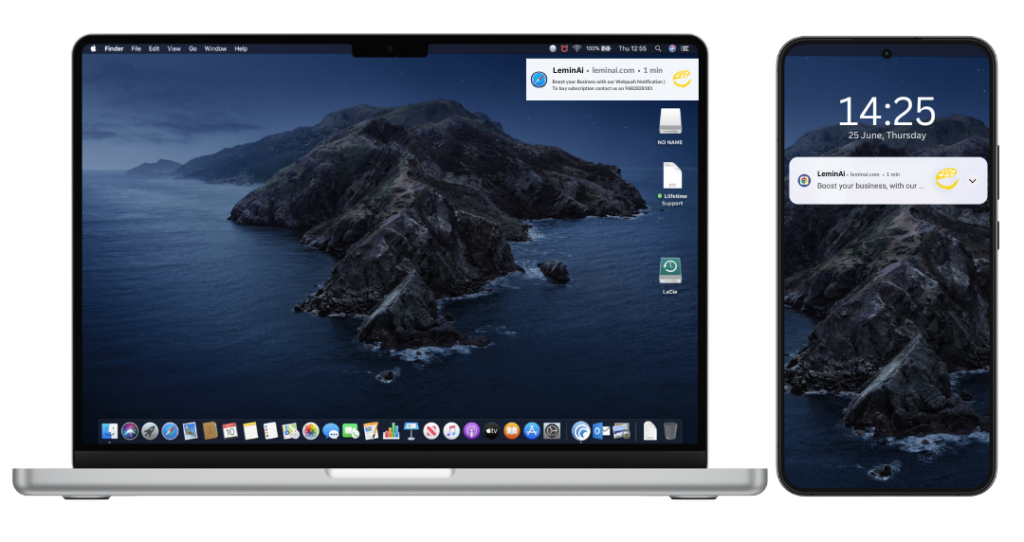
As part of a modern marketing strategy, website push notifications complement traditional communication channels like Email and SMS. In fact, they often outperform these channels due to their direct, real-time nature, making them an effective tool for businesses aiming to engage and retain users efficiently.
How Does a Web Push Notification Work?
Understanding how web push notifications chrome work is crucial for leveraging their full potential. These notifications allow websites to send messages directly to a user’s browser, even when they are not actively browsing the website. Here’s a breakdown of how push notifications typically function, including how LeminAi enhances the process:
Step 1: User Opt-In
The process begins when a user visits a website and is prompted to opt-in for push notifications. To start receiving them, the user must grant permission to allow notifications from the site. This opt-in process is essential because it ensures users have control over what notifications they receive.
Step 2: Subscription
Once a user opts in, their browser generates a unique identifier for that specific device or user. This subscription process allows the website to store that ID and send web push notifications directly to the user’s browser, whether the website is open or not.
Step 3: Lifetime Connectivity
With LeminAi Web Push, even after users leave your site, you can continue sending notifications to their device. This means the connection lasts beyond their initial visit, ensuring that you can engage them later with updates, promotions, or reminders. LeminAi allows you to send unlimited push notifications to these subscribers, maintaining a long-term connection with users who may have only visited your website once.
Step 4: Seamless Delivery
One key advantage of web push notifications is their ability to reach users instantly. Whether users are on desktops, tablets, or mobile devices, LeminAi Web Push delivers notifications directly to their screen as a pop-up message. This occurs even if the website is not open, offering a significant advantage over other communication channels like email, which users may overlook or find in spam folders.
Step 5: Engagement
Once a mobile web push notification is delivered, users can interact with it, usually through clickable call-to-action buttons. For example, users might be prompted to click and return to the website, check out a special offer, or complete an action like making a purchase. This interaction boosts user engagement and drives conversions. LeminAi Web Push makes this process smooth by offering tools that encourage users to take action, improving overall user experience and helping businesses achieve their marketing goals.
Step 6: Rich Media Integration
To make notifications even more appealing, web push notifications can include rich media such as images, links, and buttons. This helps make the notifications more visually engaging and provides more context to users. Rich media can increase the likelihood of users clicking through, helping to drive traffic back to the website and improve conversion rates.
By following this process, web push notifications are an effective way to stay connected with users, even when they are not actively engaging with your website. Services like LeminAi Web Push take this functionality a step further by offering lifetime connectivity, seamless delivery, and advanced engagement features. Whether your audience is on desktop or mobile, push notifications are a powerful tool for building long-term relationships and driving business growth.
Types of Web Push Notifications
1. Bulk Web Push Notifications
Bulk web push notifications reach your entire audience with broad communication. Marketers typically use them for announcements like sales, new blog posts, or general updates. The advantage of bulk notifications is that they reach a large number of users with minimal effort, making them a great tool for businesses to keep their audience informed.
However, since bulk web push notifications chrome target everyone, they may not always be relevant to all users. This is where segmented web push notifications come into play.
2. Segmented Web Push Notifications
On the other hand, segmented web push notifications are tailored to specific groups within your audience. These notifications target users based on criteria such as location, behavior, or past interactions with the website. By segmenting your audience, you ensure that the notifications they receive are relevant to their interests, which can lead to higher engagement rates.
Segmented web push notifications drive higher click-through rates for marketers by targeting specific user groups and personalizing messages to meet their unique needs.
For instance, an e-commerce website might send a web push notification about a special discount to users who have previously purchased similar products. This personalization helps improve the user experience, making it a powerful strategy for conversion.
Benefits of Web Push Notifications
1. Instant Delivery and High Visibility
One of the main advantages of web push notifications is their instant delivery. Unlike emails, which might end up in spam folders or get overlooked, push notifications appear directly on a user’s screen. This high visibility leads to increased engagement and immediate action.
2. Increased User Retention
When used correctly, push notifications can significantly boost user retention. By sending personalized, timely updates, businesses can keep users coming back. For example, mobile web push notifications can remind users about abandoned shopping carts, enticing them to complete their purchases.
3. Higher Click-Through Rates (CTR)
Studies show that web push notifications achieve much higher click-through rates than emails. Delivered directly to the user’s device and requiring immediate action, push notifications prompt users to click, driving more traffic to your website.
4. No App Required
Another benefit of website push notifications is that they work without needing a dedicated app. Users can receive notifications even if they are not actively on your website, as long as their browser is open. This makes browser notifications an effective tool for engaging users across different devices.
5. Cost-Effective
Compared to other forms of marketing, mobile web push notifications are highly cost-effective. You don’t need to invest in developing a mobile app or pay for SMS campaigns. Plus, many free push browser notifications services allow you to send notifications without any upfront costs.
6. Expand Your Marketing Reach with Web Push Notifications
Web push notifications offer an additional marketing channel that works seamlessly with your email campaigns. Unlike emails that often get buried in busy inboxes, push notifications appear directly on users’ devices, ensuring your message stands out.
One key advantage of mobile web push notifications is that they ensure your messages are seen—even if users are not currently on your website. For example, if a user isn’t on your site when you send a push notification, they will still see it when they open their browser later. Imagine sending a web push notification of a promotional offer at 6:00 PM while a user is offline and not connected to the internet, they will still see the notification when they come online later. Let’s say they reconnect at 7:30 PM; the notification will pop up on the top-right corner of their screen, ensuring they don’t miss out.
Furthermore, push notifications reach users on all devices, including Android smartphones, tablets, and desktops, expanding your marketing reach and boosting engagement across multiple platforms.
Web Push Service Provider: LeminAi
To fully harness the power of web push notifications, businesses need a reliable service provider. LeminAi is a comprehensive push notification service that offers advanced features to help websites grow and engage their audience.
Features of LeminAi
- Easy Integration: Setup LeminAi Webpush in a jiffy with our ready integrations. Our products have zero developer intervention making it easy and smooth to get started.
- Targeted Messaging: With segmentation capabilities, LeminAi allows businesses to send personalized browser push notifications based on user behavior, location, language, device, browsers, URLs, and more.
- Analytics: LeminAi offers detailed analytics to track the performance of each campaign, ensuring that businesses can optimize their push notifications for maximum impact.
- Real-Time Delivery: Whether it’s a special offer or an urgent update, LeminAi ensures that web push notifications reach all subscribers in real time.
- Affordable Pricing: Get all these features for just ₹299/month! LeminAi Web Push provides a budget-friendly solution for businesses to engage users and boost conversions.
By using LeminAi’s free push notification service, businesses can leverage the full potential of website push notifications without any upfront costs, making it an ideal solution for both small and large enterprises.
Start Your 15-Day Free Trial Now!
Try LeminAi’s free push notification services with our 15-day FREE trial. No credit card is required—experience the full power of our push notification service before committing.
For more information on our free push notification service and LeminAi’s web notification call us at +91-9682828181.
Conclusion
In conclusion, website push notifications are a powerful tool for businesses looking to enhance user engagement and drive conversions. Whether you choose bulk web push notifications for mass updates or segmented web push notifications for personalized messaging, these notifications offer numerous benefits. They allow businesses to reach users instantly, increase retention, and drive more traffic with minimal effort.
For those looking to integrate mobile web push notifications into their marketing strategy, a reliable push notification service like LeminAi can simplify the process and ensure successful campaigns. By taking advantage of this technology, businesses can improve their communication with customers and see greater returns on their marketing efforts.


